The walk from Miradouro da Vista do Rei down to the village of Sete Cidades is among the most atmospheric hikes in São Miguel. It begins high, nearly in the clouds, with a panoramic vantage point. Below you are the famous twin lakes—one green, one blue—nestled in the volcanic caldeira like liquid mirrors.
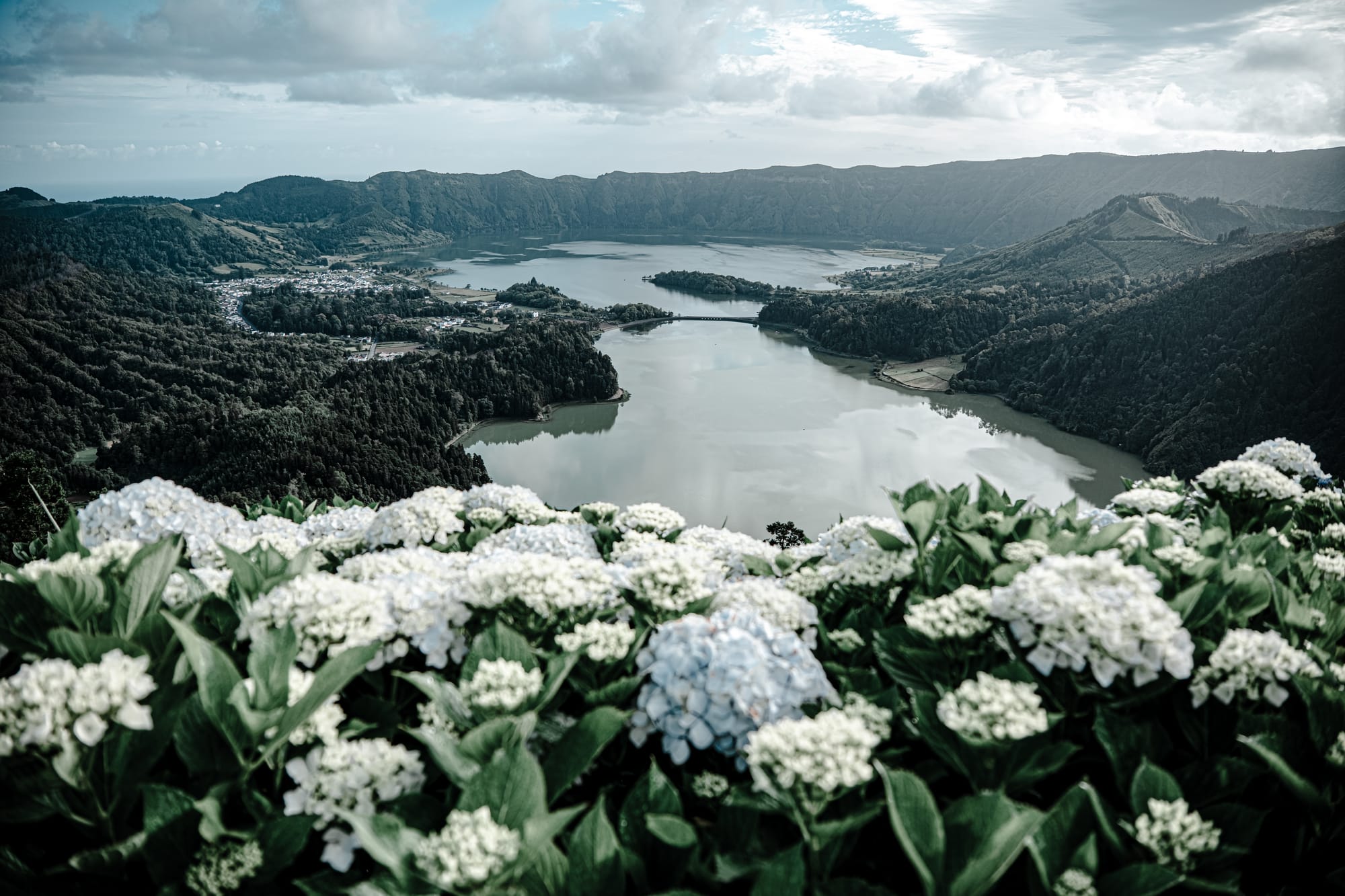
It’s an ideal spot to pause before your descent. From the viewpoint, you can see not only the curves of Lagoa Azul and Lagoa Verde but also the faint outline of Sete Cidades town at the base of the valley. You’re not just looking at a trail—you’re about to walk into a living painting.
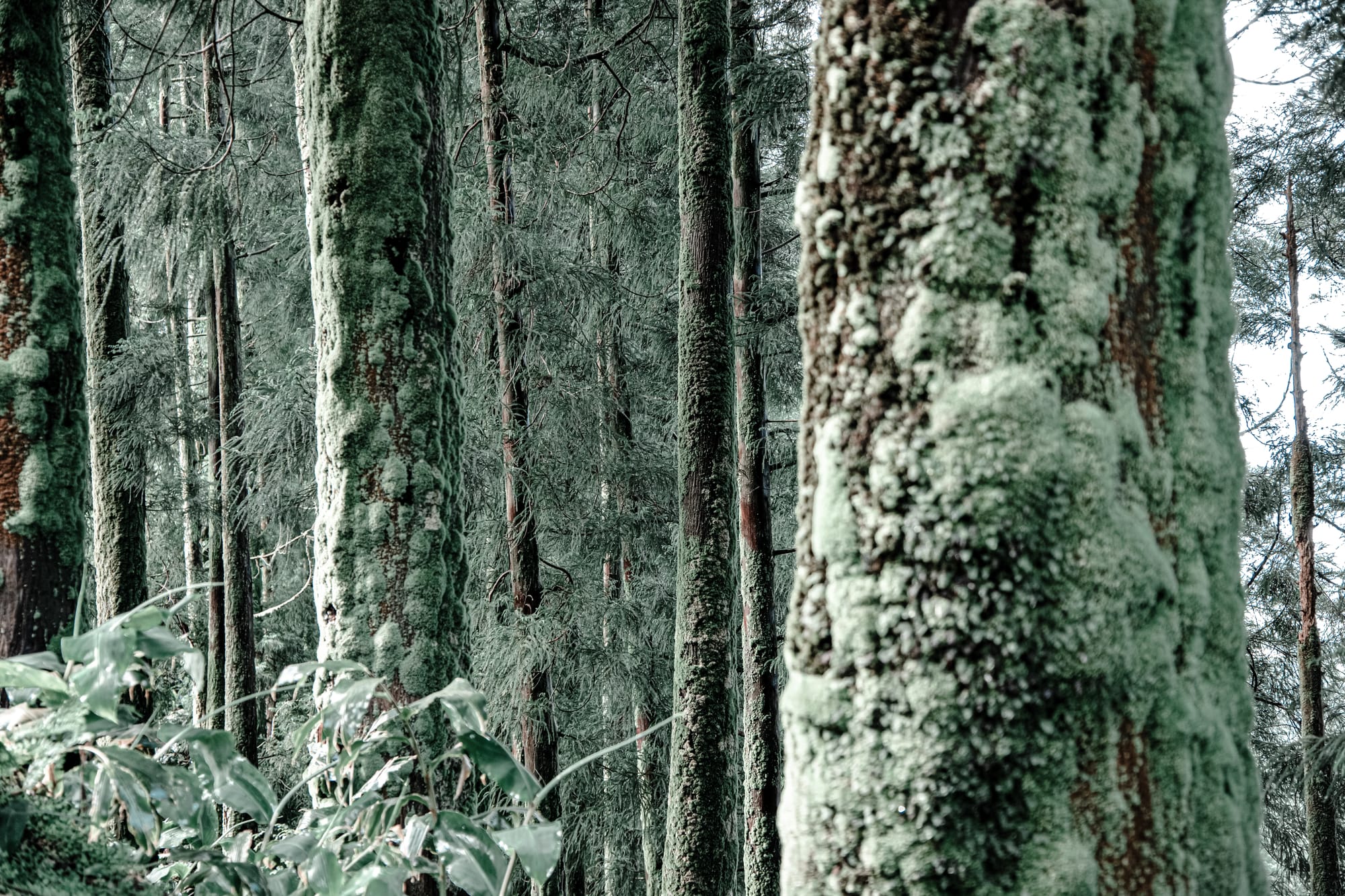
Before you go: read more about this viewpoint and others in our post on our favorite São Miguel miradouros and consider pairing this with a visit to the abandoned Monte Palace hotel, which looms ghostlike just meters from the trailhead.
A walk that descends through myth
The hike from Vista do Rei to Sete Cidades follows a ridgeline that unfurls slowly, offering shifting views of the lakes below. This route is officially known as the PR3-SMI trail—one of the most scenic and accessible hikes in the Azores. Some sections follow a dirt road, others wind through overgrown ferns and past moss-covered stone walls. The trail is gentle but long—expect to walk for several hours, especially if you linger (and you will).
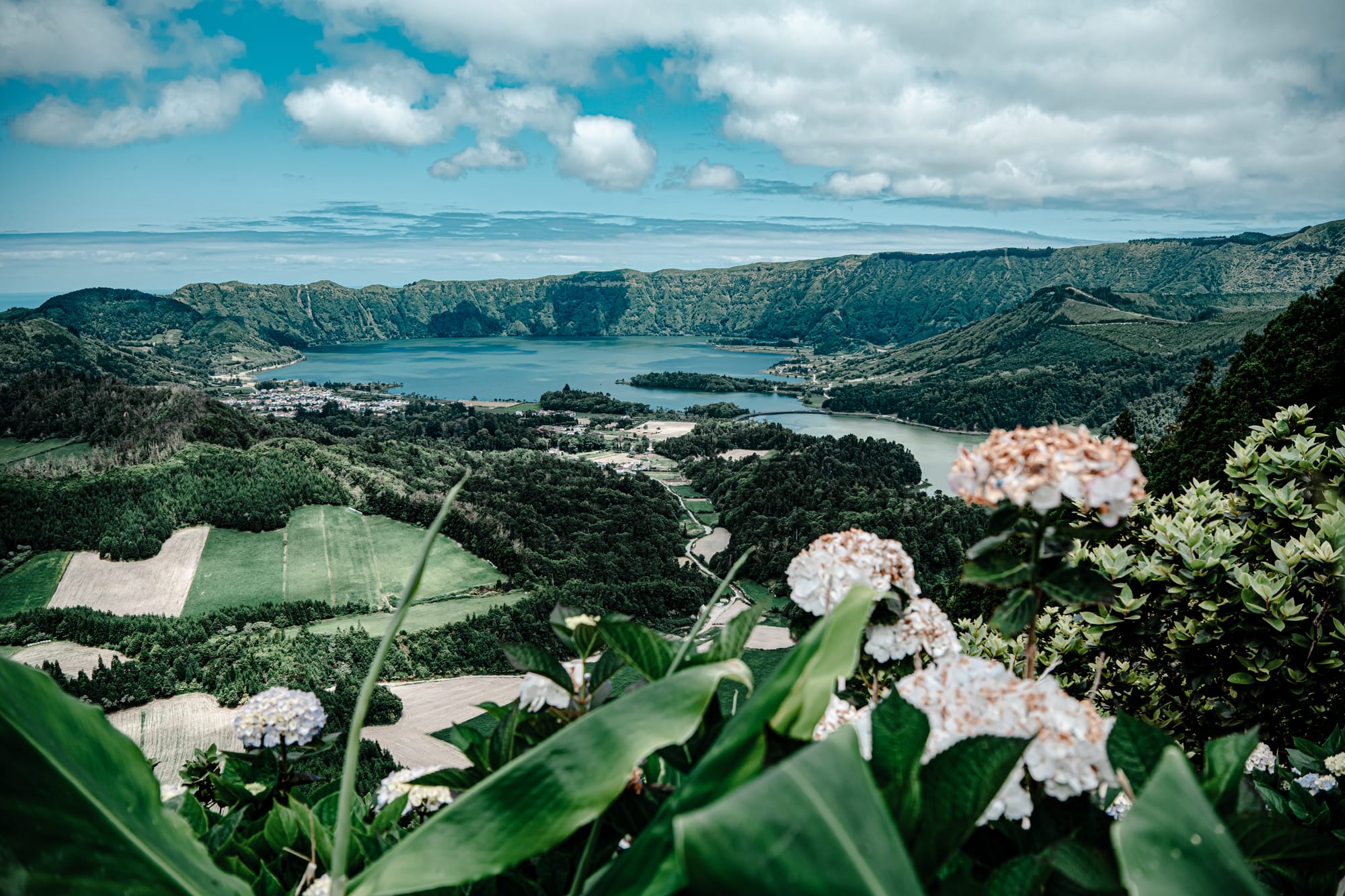
Much of the hike skirts the edge of the caldeira. On one side: sheer green slopes, sometimes covered in fields of wildflowers. On the other: sudden openings that reveal the blue and green lakes, stacked like reflections.
These lakes are famously tied to a local legend. The story tells of a princess and a shepherd who fell in love but were forbidden to be together. Their tears formed the two lakes—hers green, his blue—divided by a narrow bridge but forever close. It’s sentimental, yes, but standing above them, watching the colors shift as clouds pass overhead, it’s hard not to feel it.
As you continue down, the trail passes through dense botanical corridors. You'll see thick hedges of white and blue hydrangeas lining the path, blooming madly as if untamed. Patches of wildflowers shimmer.
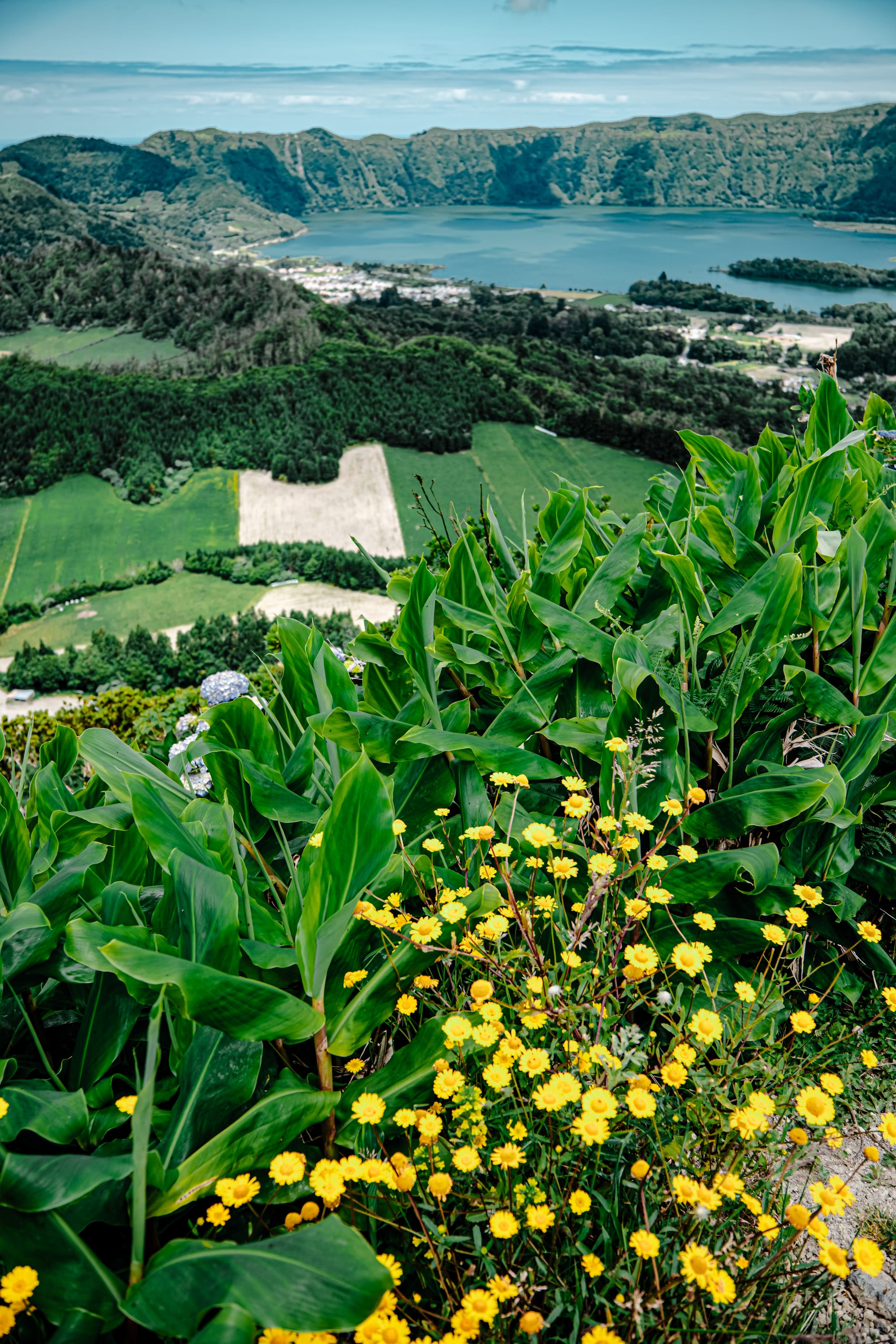
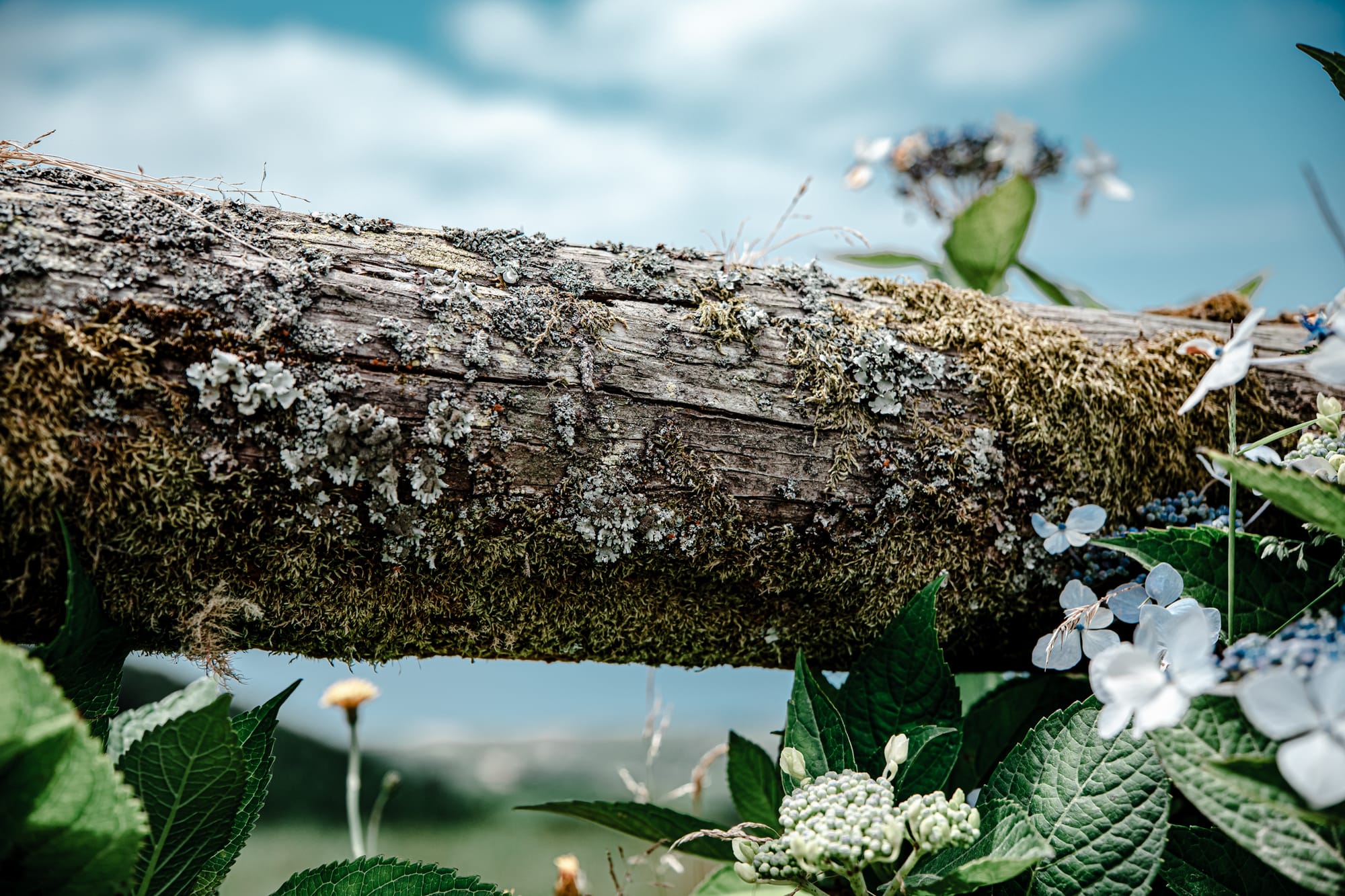
Verdant crater views and close-up botanical textures along the PR3-SMI trail
You pass wide farm fields marked by stone boundaries, occasionally crossed by wandering cows or framed by wind-shaped trees. In some sections, the hills open in sweeping vistas not of water but of land—rolling ridges, rows of planted crops, rooftops catching sun.
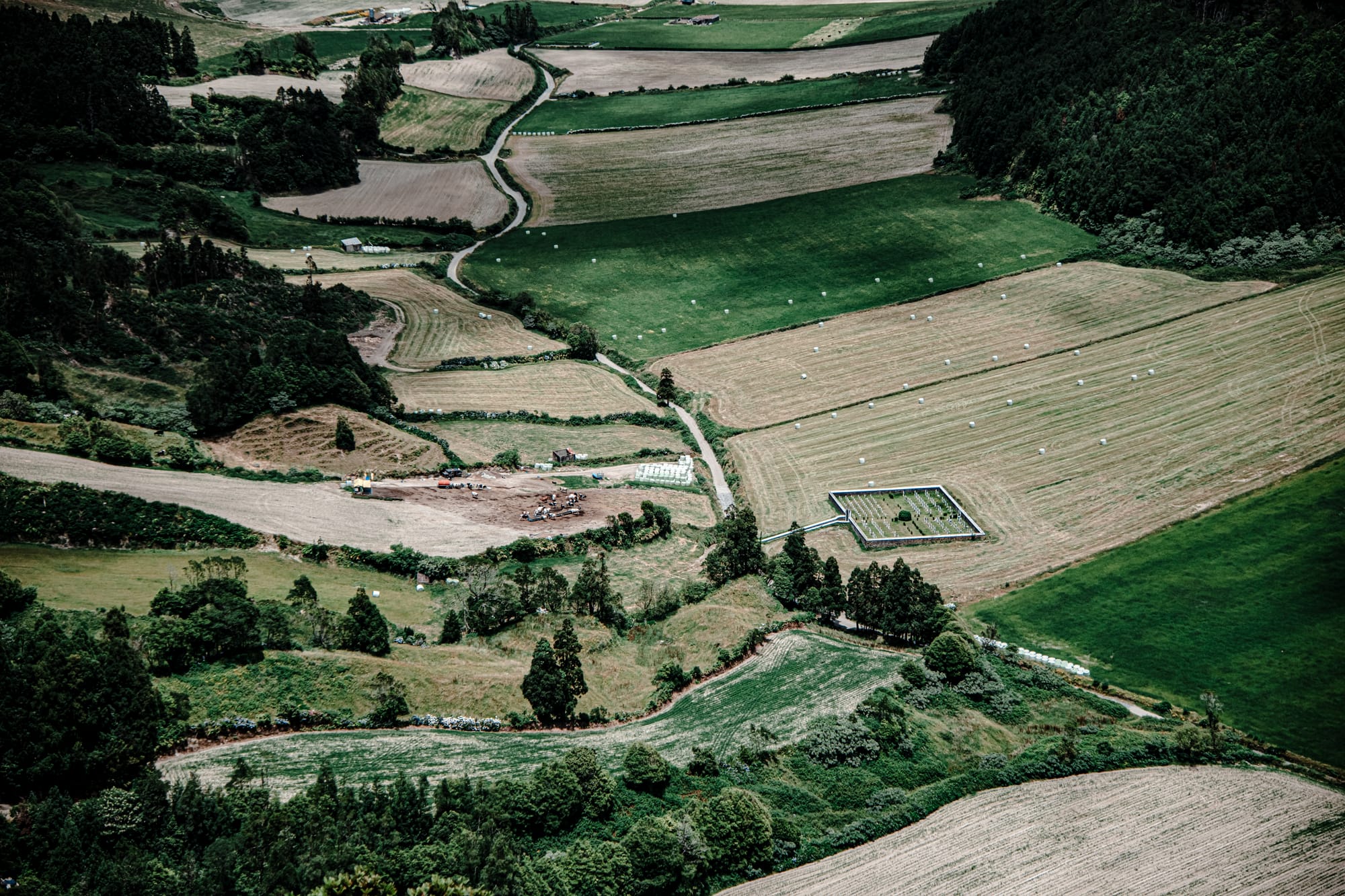
These stretches bring a balance to the hike, revealing the lived, agricultural rhythm of São Miguel alongside its showstopping lakes.
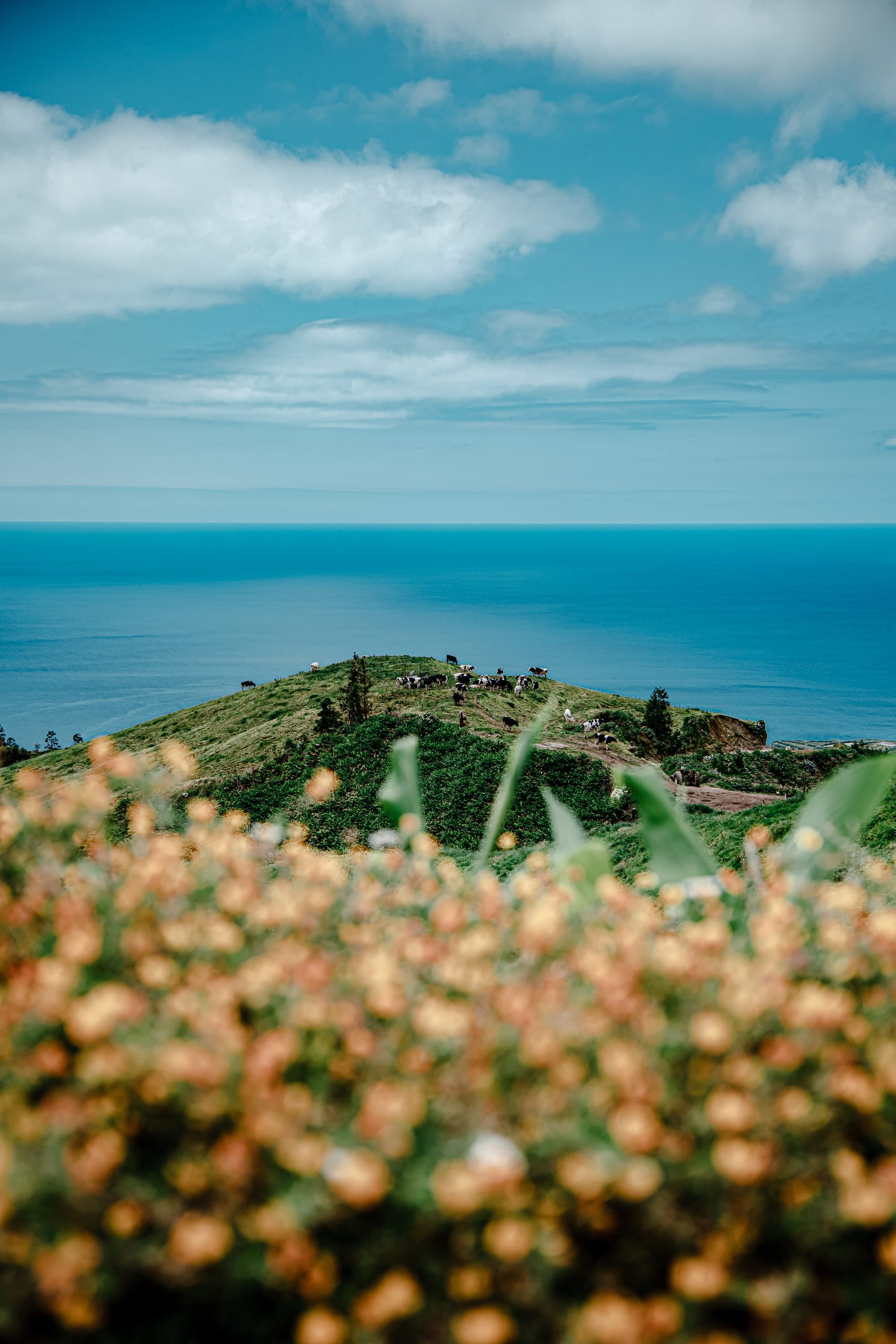
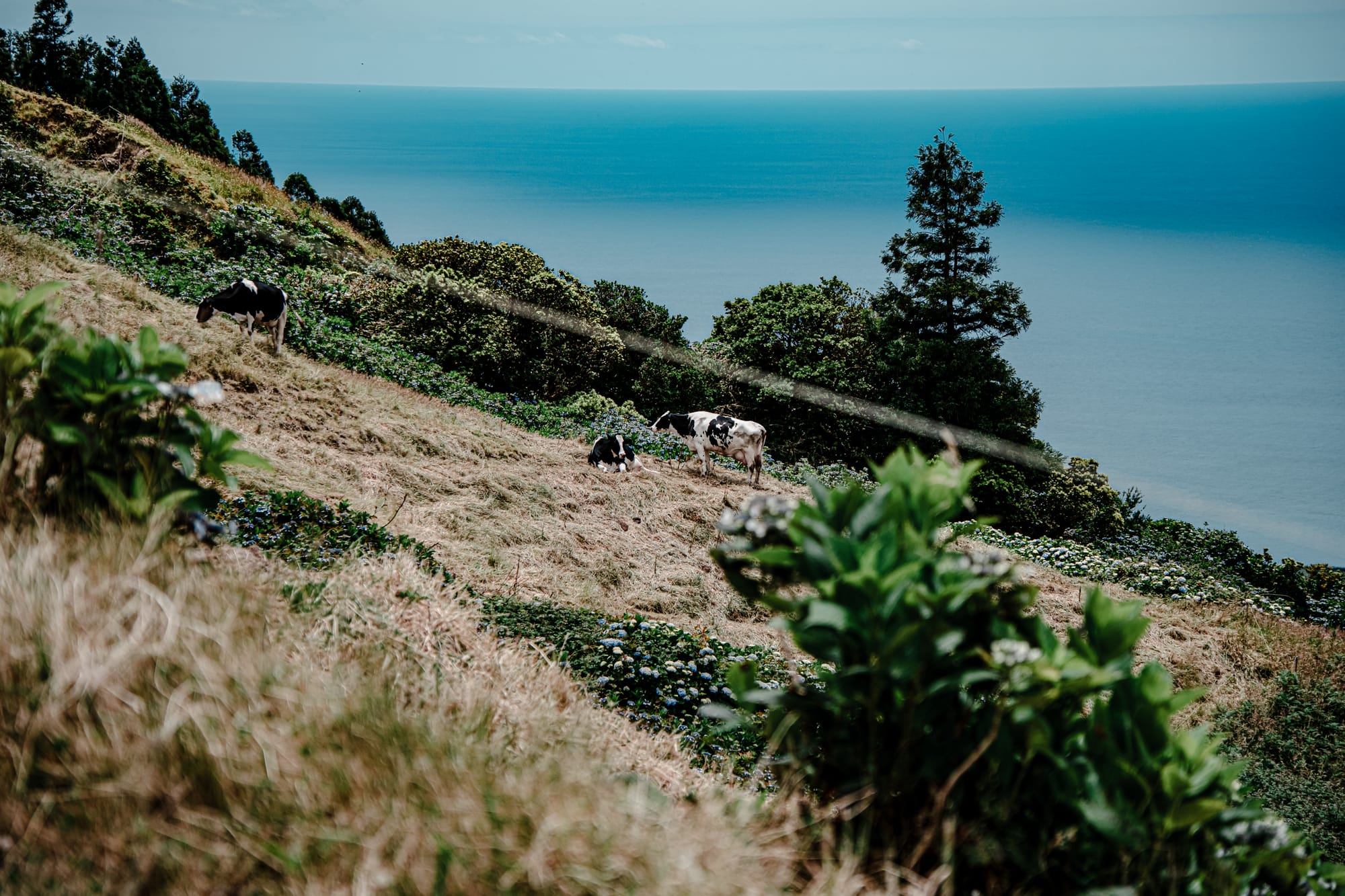
Cows graze along steep pastures with sweeping views of the Atlantic Ocean on the PR3-SMI trail
There are stretches where the trail is flanked by fields of ginger lily and stone pines, and others where tree ferns unfurl in spirals and hearts.

Moss carpets the ground beneath conifers, and in some places, tree trunks are bearded with lichen. A split log, half-decayed, sits covered in mushrooms and ferns.
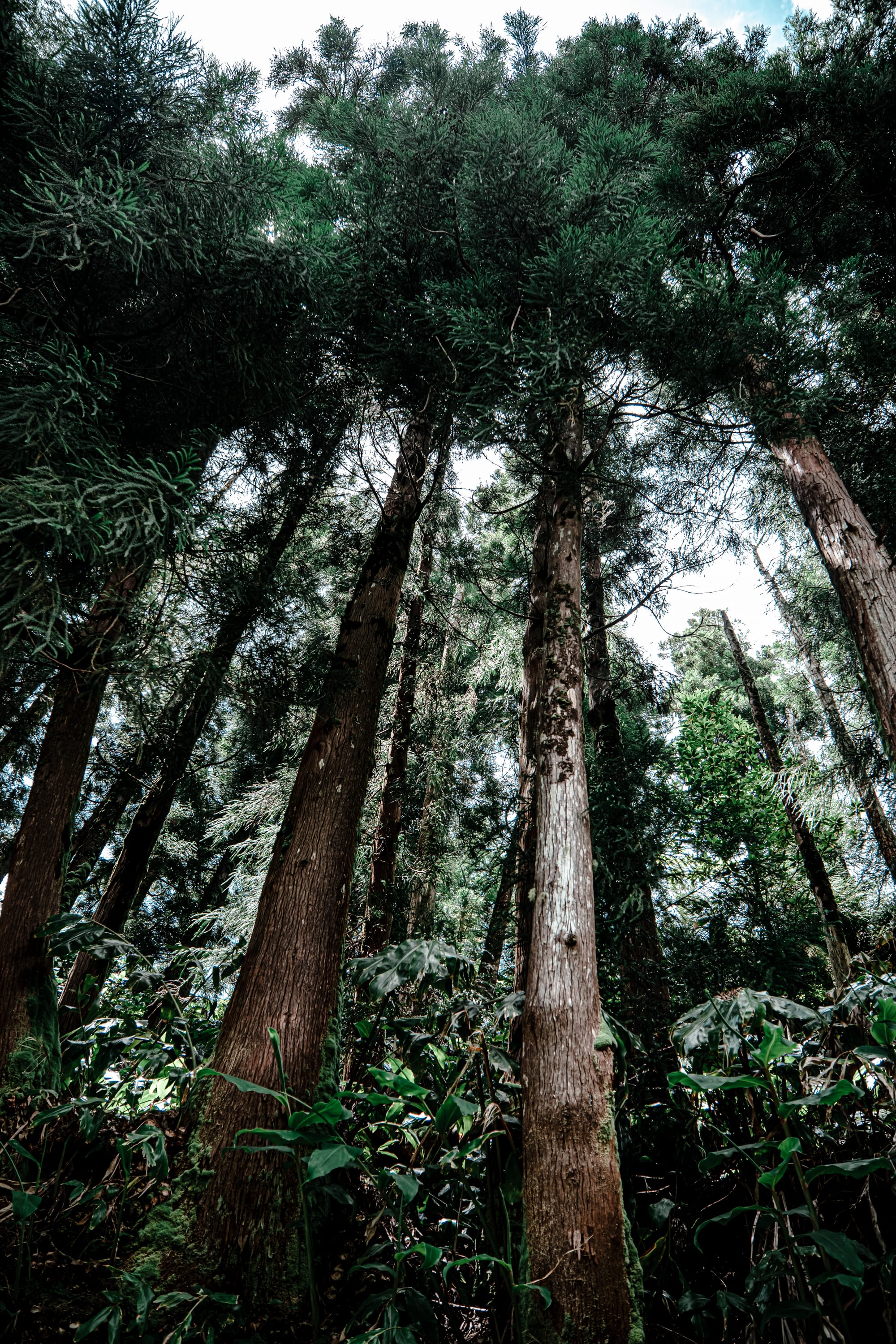
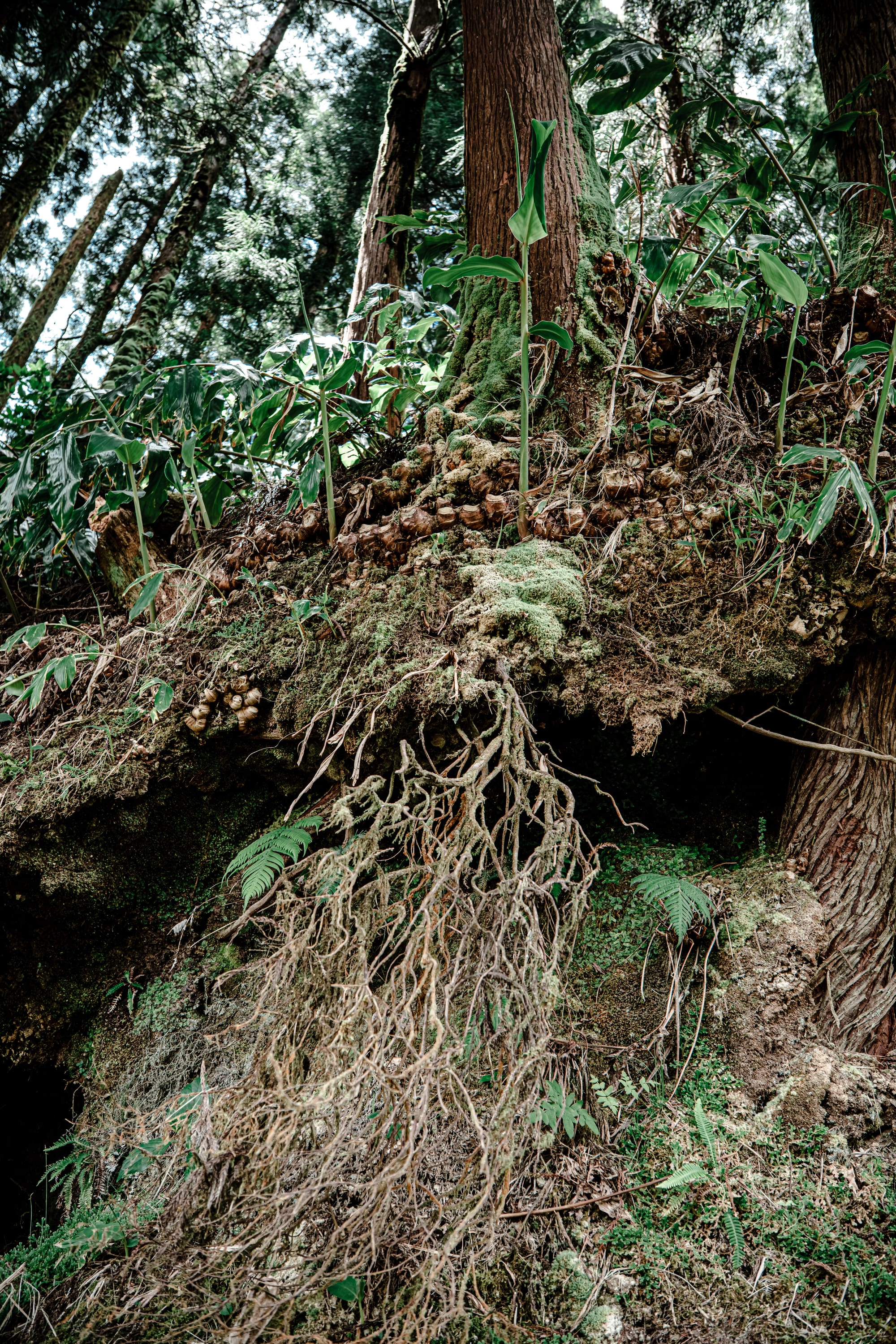
Moss-covered trees and tangled roots line the PR3-SMI trail through the forest
The vistas evolve as you descend. At one point, the lakes gleam side by side, framed by flowering hedgerows.
While the lakes command most of the attention, there are moments when the trail opens westward and the Atlantic stretches out before you—vast, silver-blue, with sky and sea folding into one.
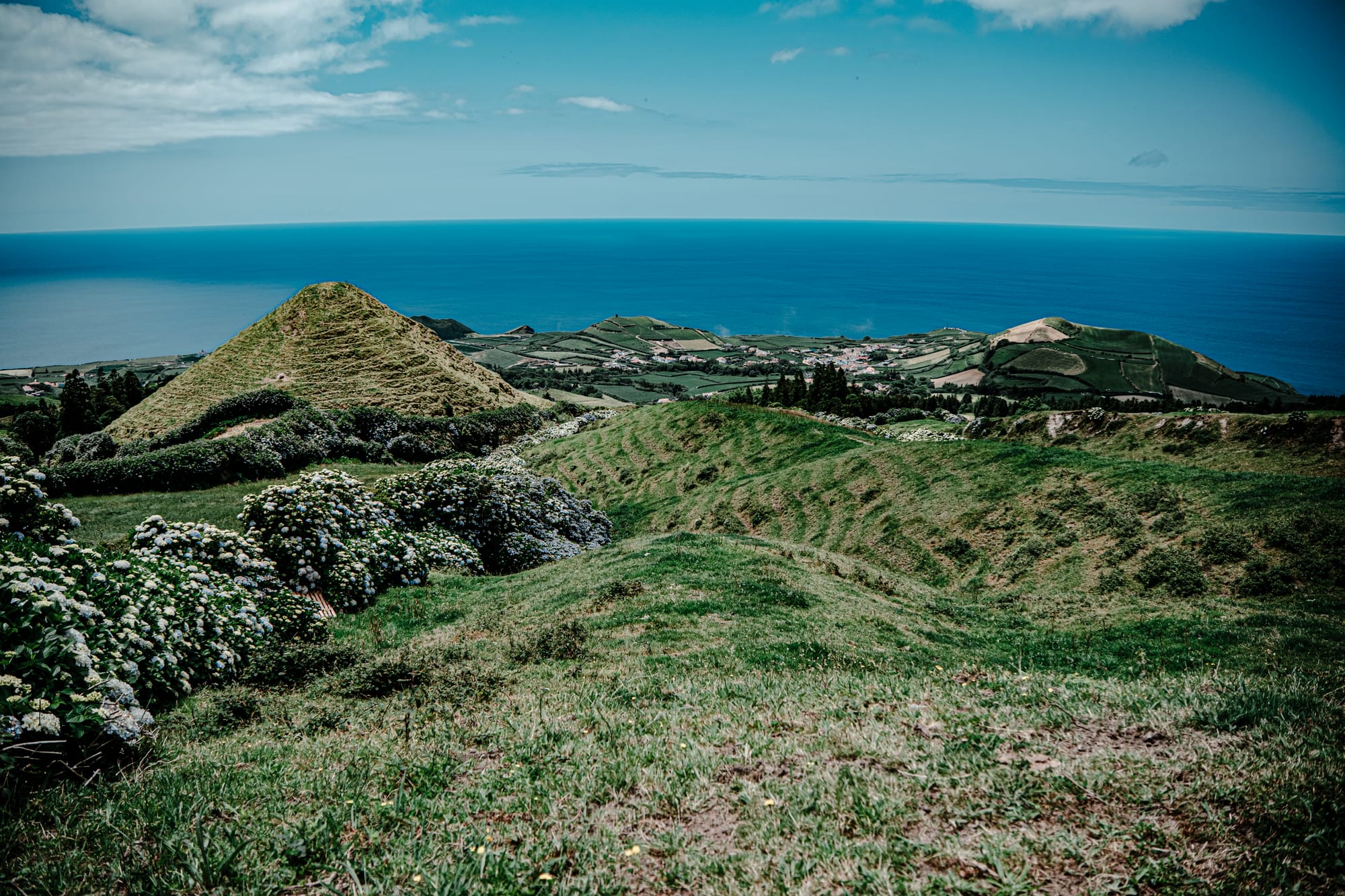
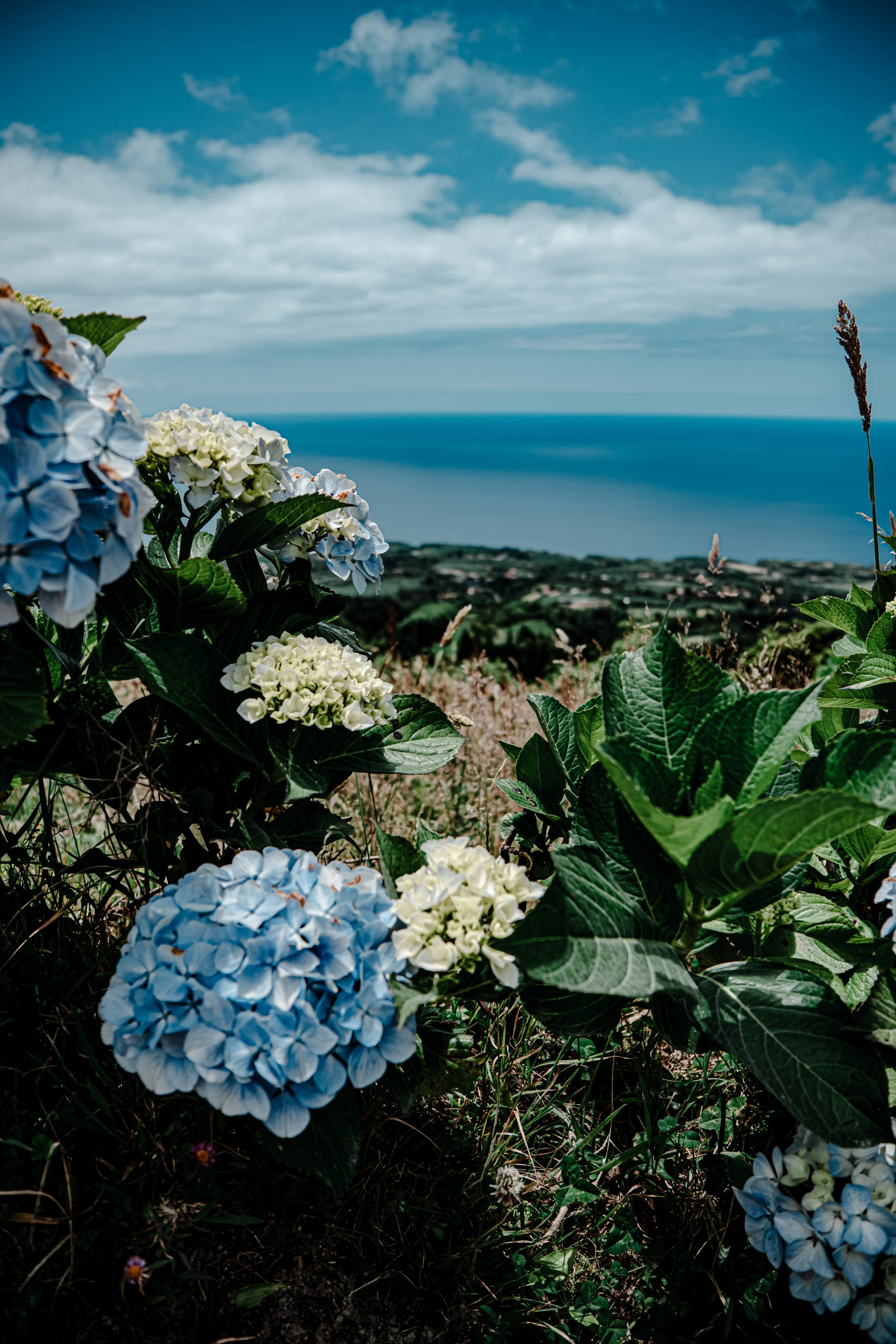
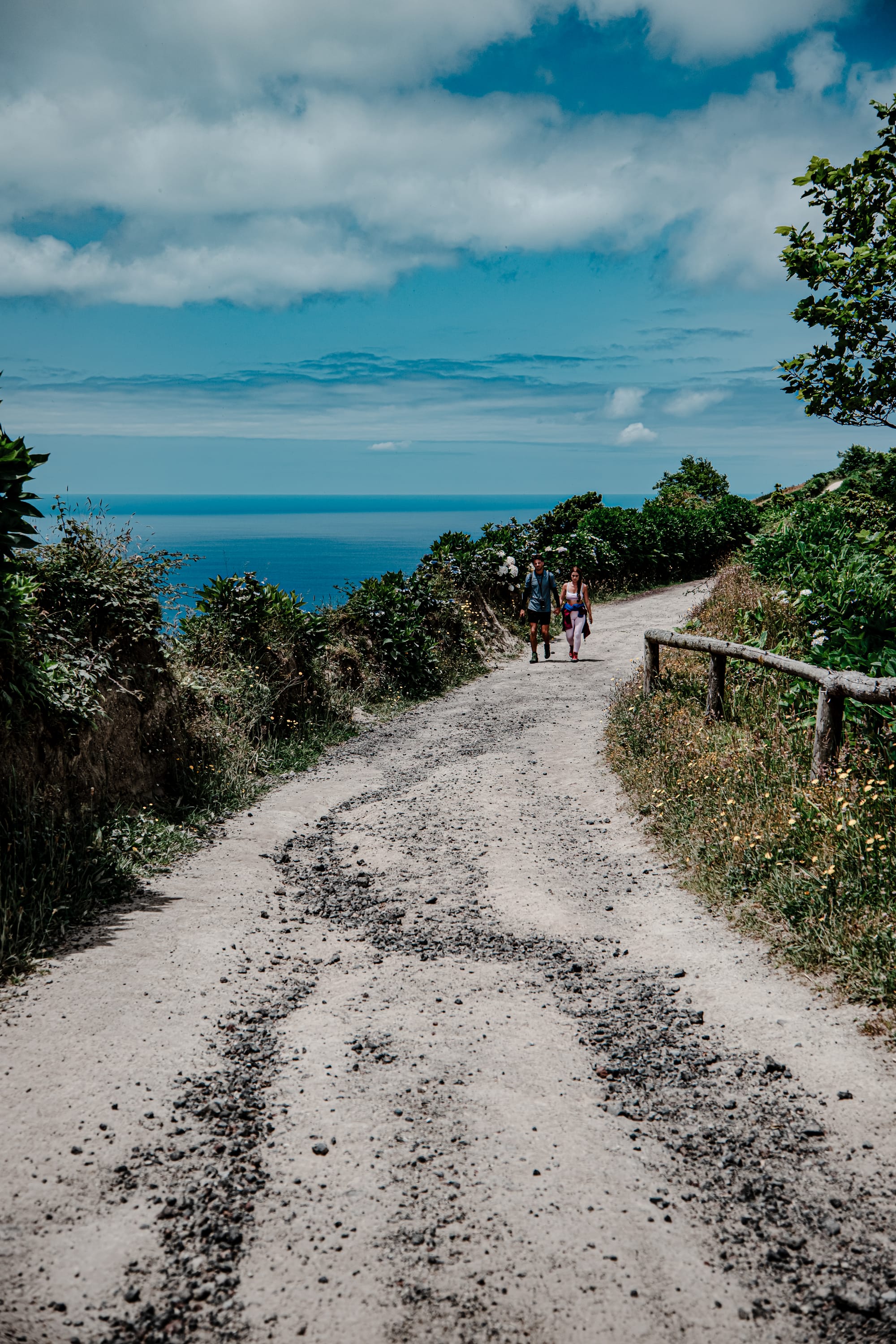
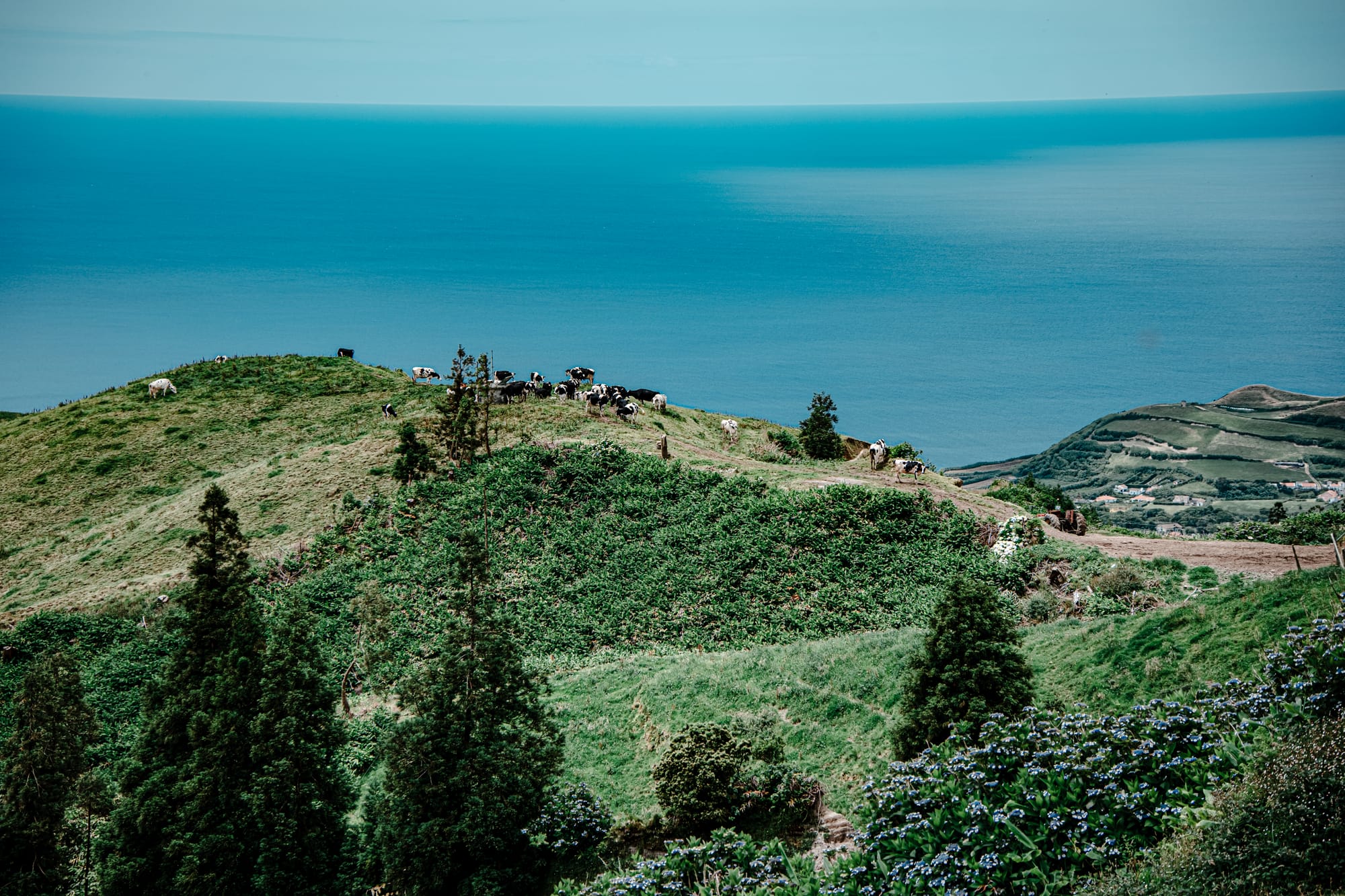
Rolling pastures, cliffside trails, and sweeping Atlantic views along the PR3-SMI trail to Sete Cidades
At several turns, the horizon pulls back to reveal sweeping ocean views, sometimes catching the glint of distant waves or the shape of a lone fishing boat moving slowly across the surface.
Near the ridgeline, there’s a clear view of a tiny offshore islet—just a sliver of land framed by sea—that reminds you how volcanic and scattered this archipelago really is.
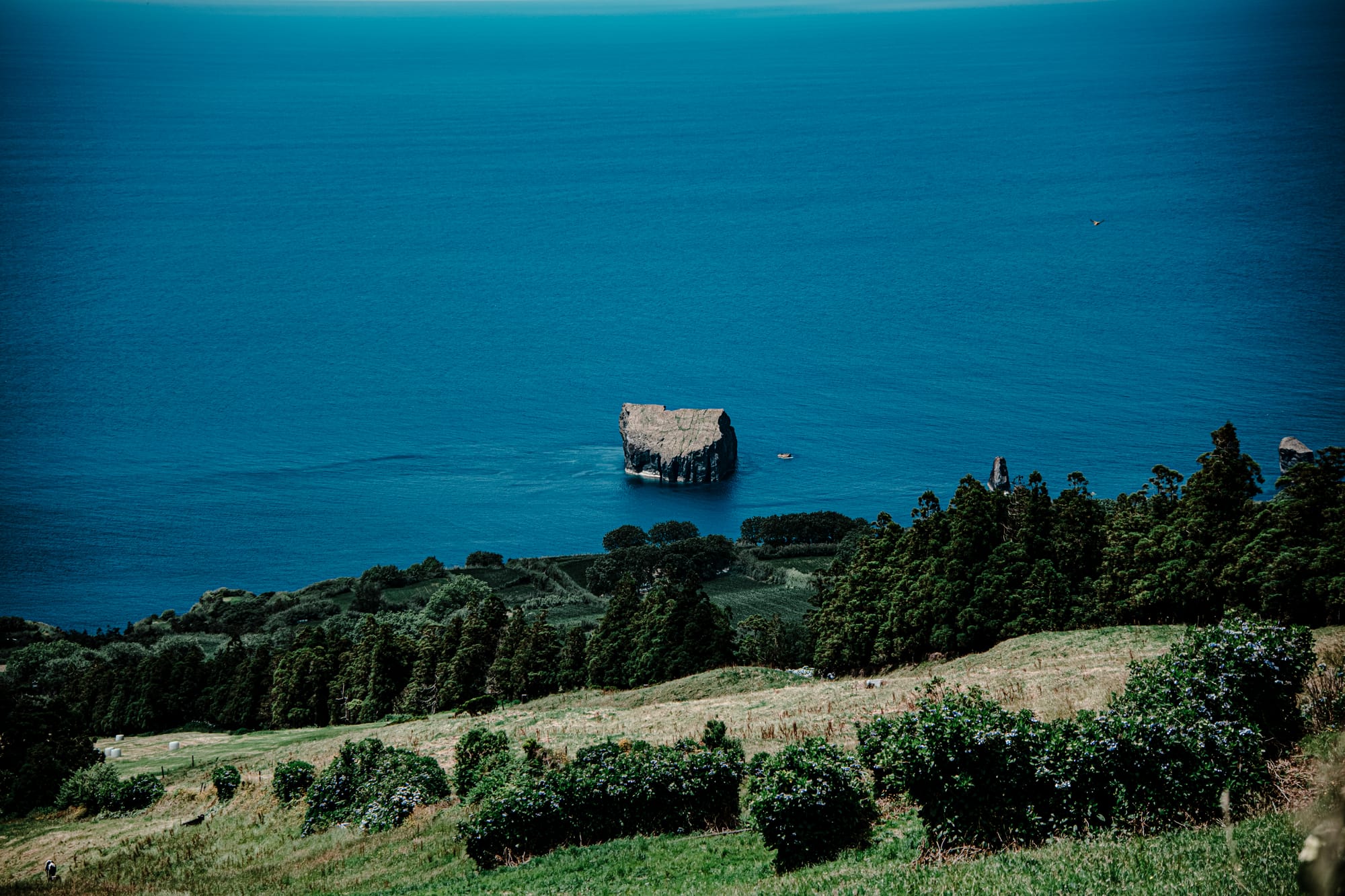
The contrast is striking: the enclosed quiet of the lakes behind you, and then suddenly, the wide, wind-shaped openness of the Atlantic appearing beside you.
There are moments of sudden stillness—no sound but the crunch of footfall and breeze through eucalyptus. When you pause, the air itself seems to settle, and the trail feels older than it is. At other points, the wind picks up and lifts petals off the hydrangeas, scattering them across the path like confetti.
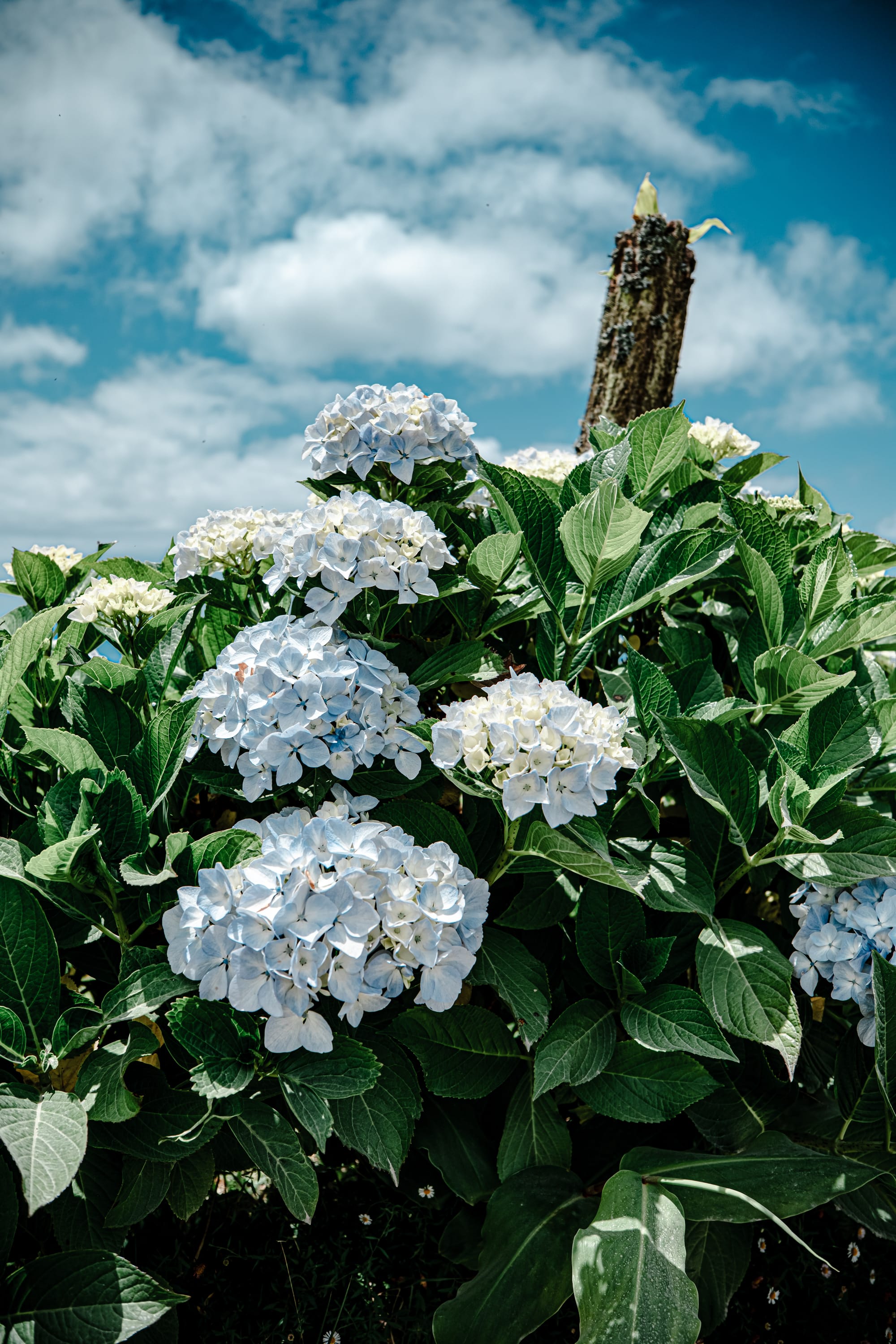
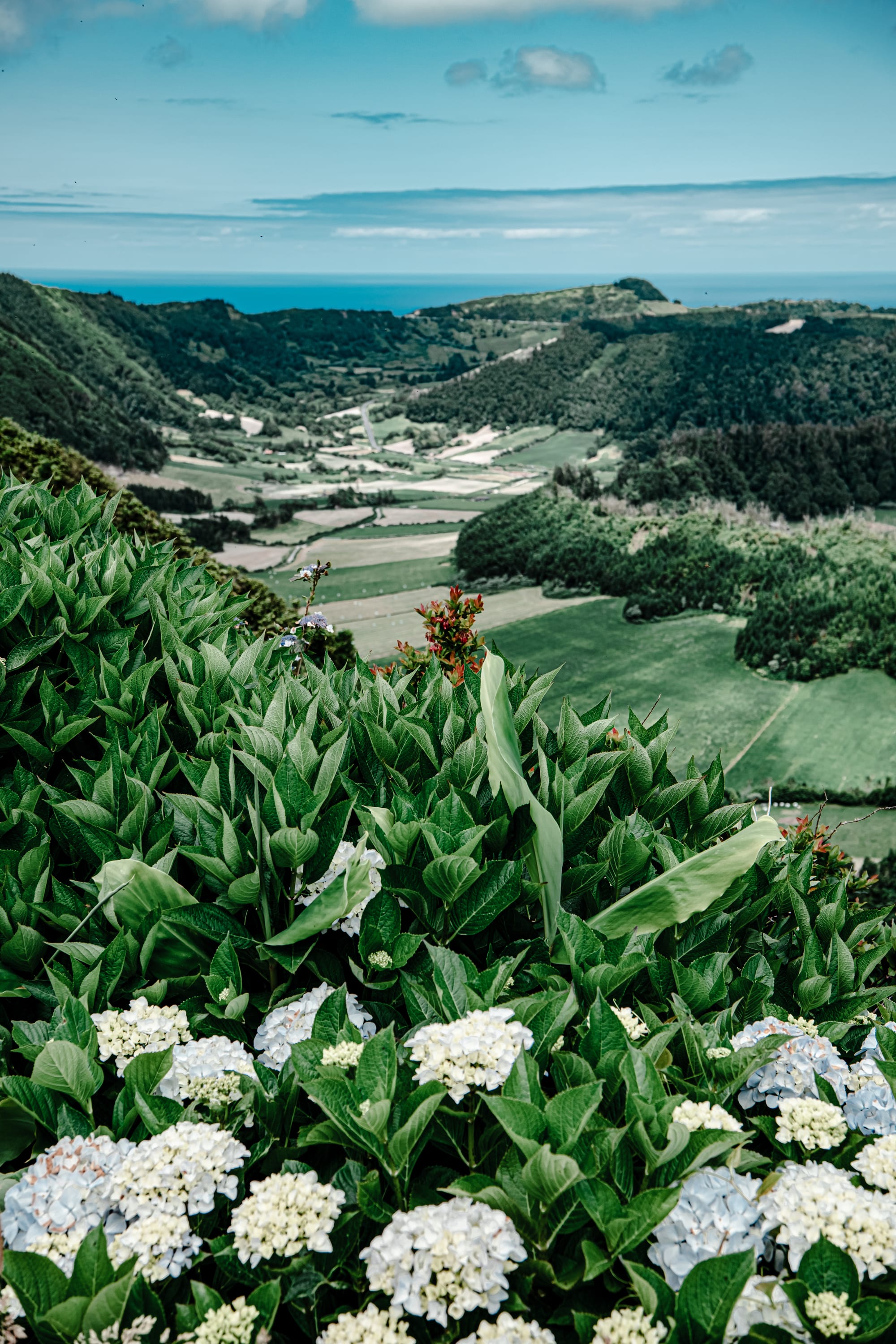
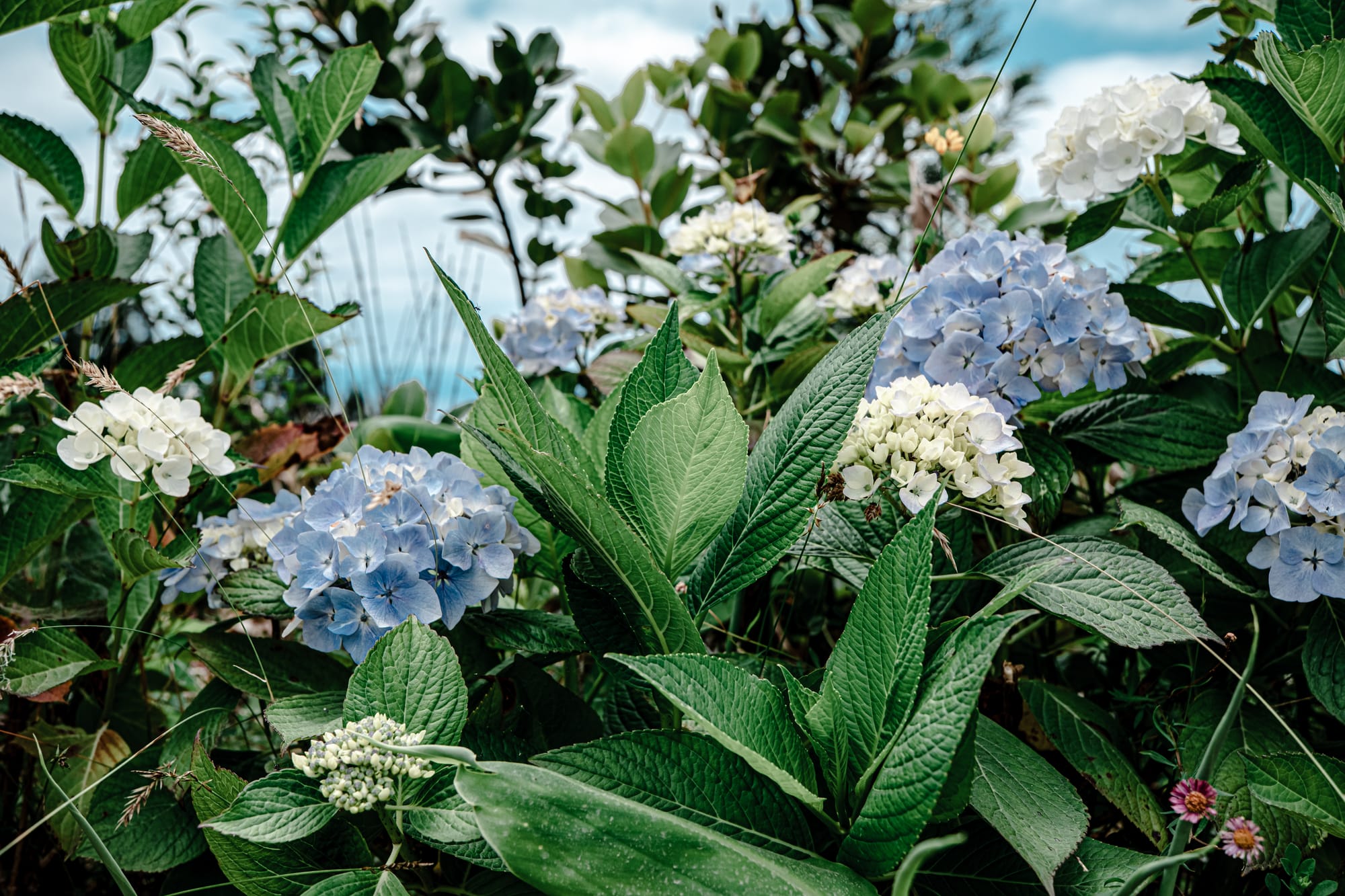
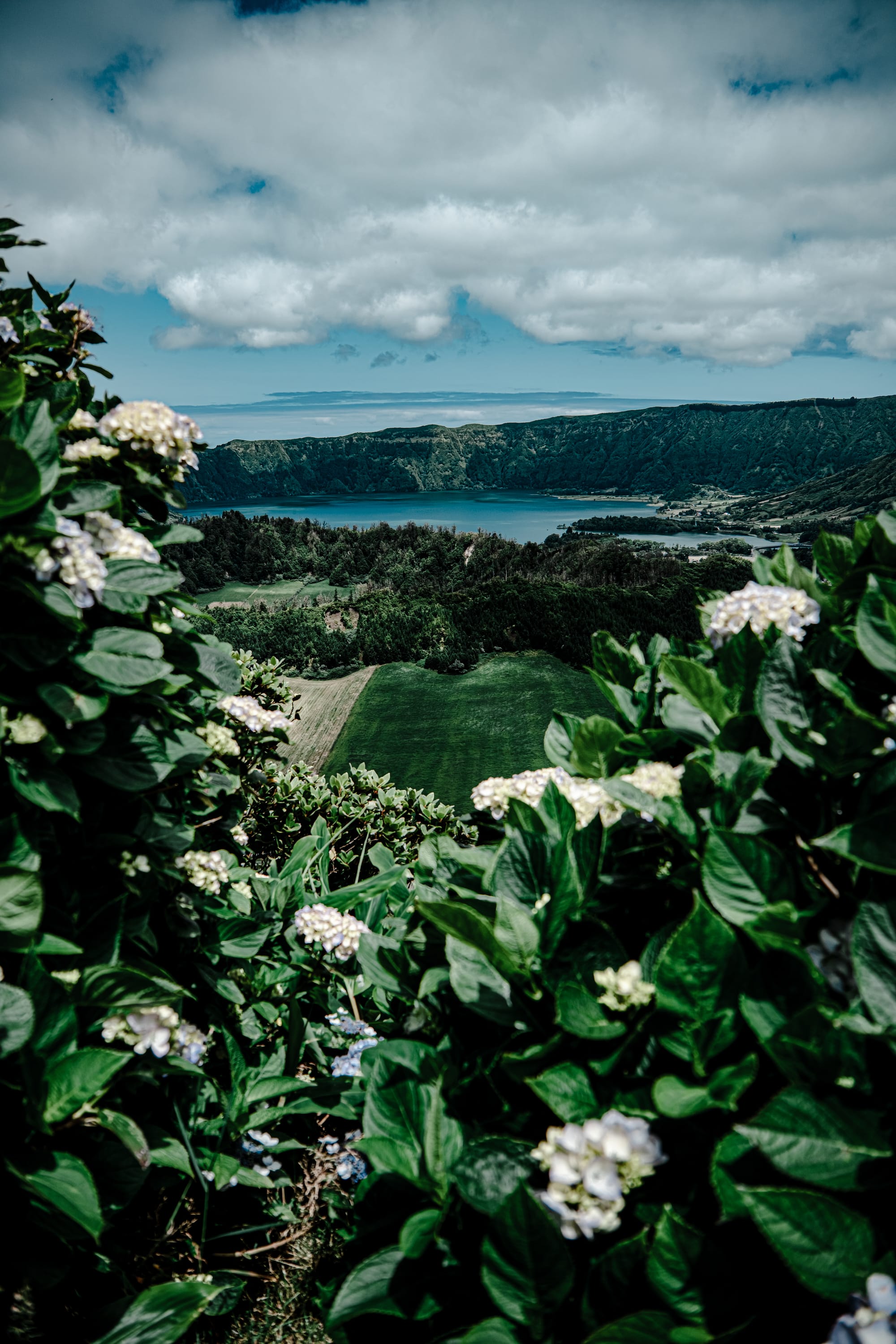
Hydrangeas bloom along the edge of the PR3-SMI trail, framing views of the inland valleys and the Atlantic
Further down, the view narrows into a more pastoral setting—grazing horses, wide dirt roads, a looping path that eventually delivers you into the basin.
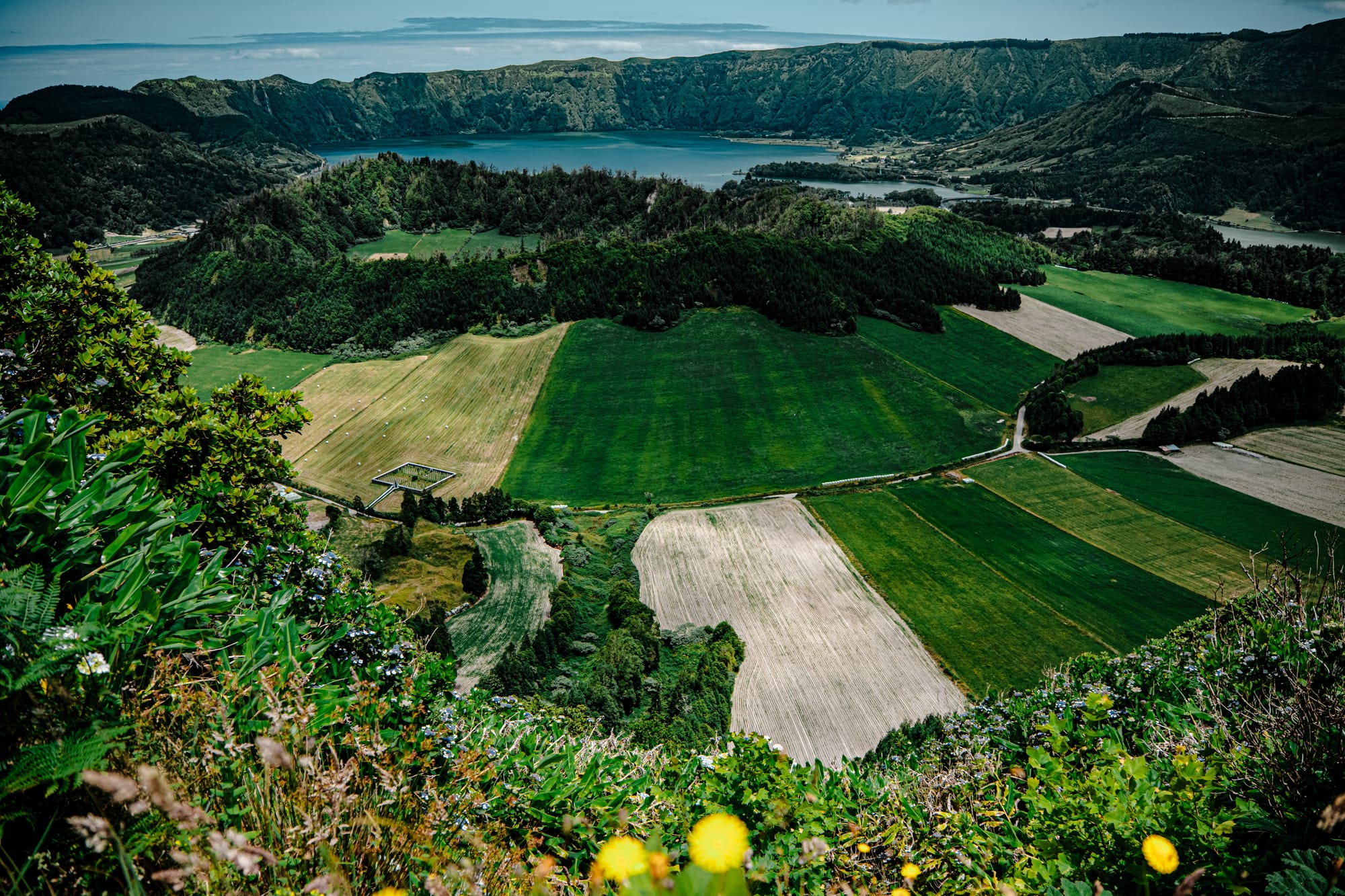
The last stretch brings you into a tunnel of green, as the trees thicken and the town draws near.
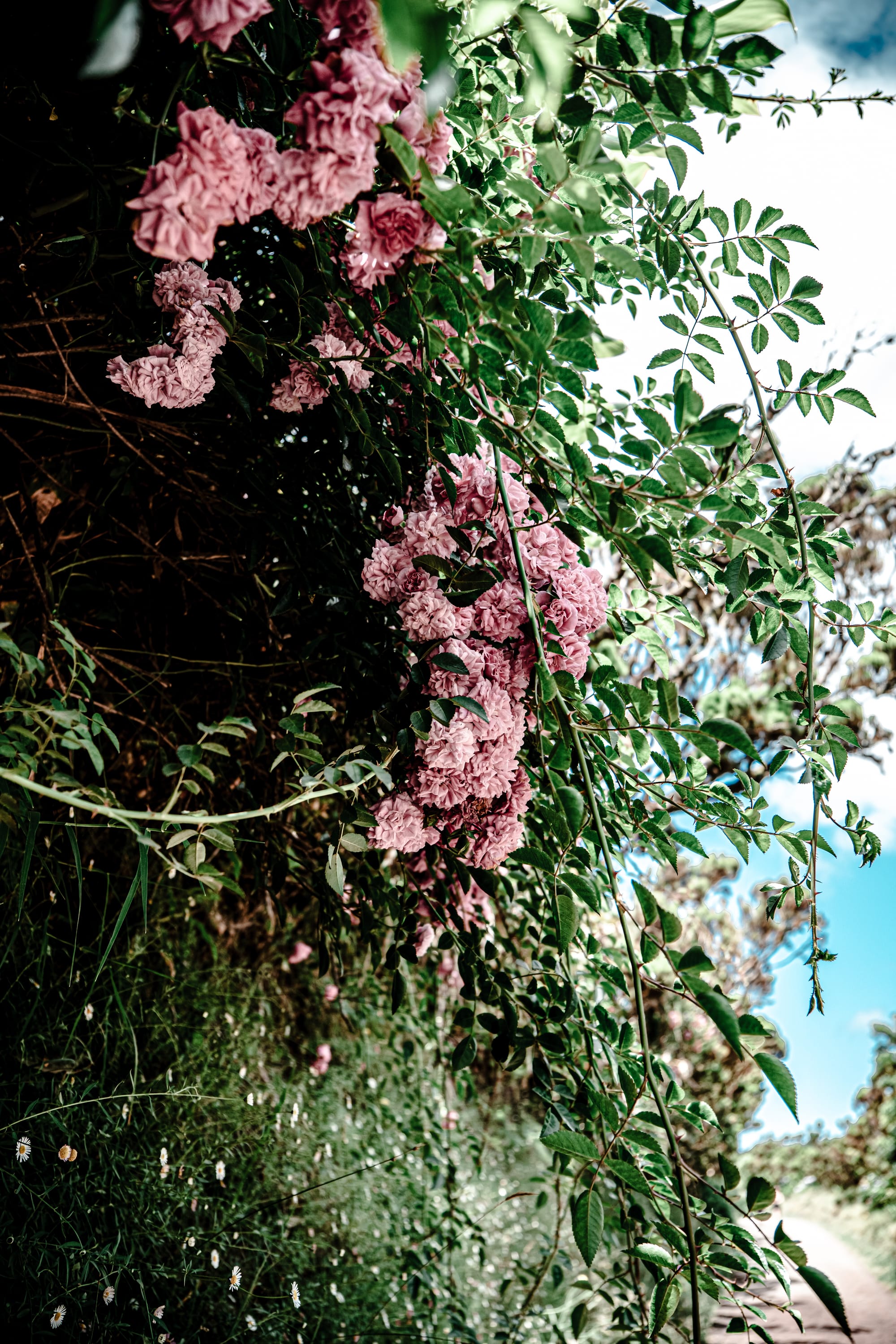
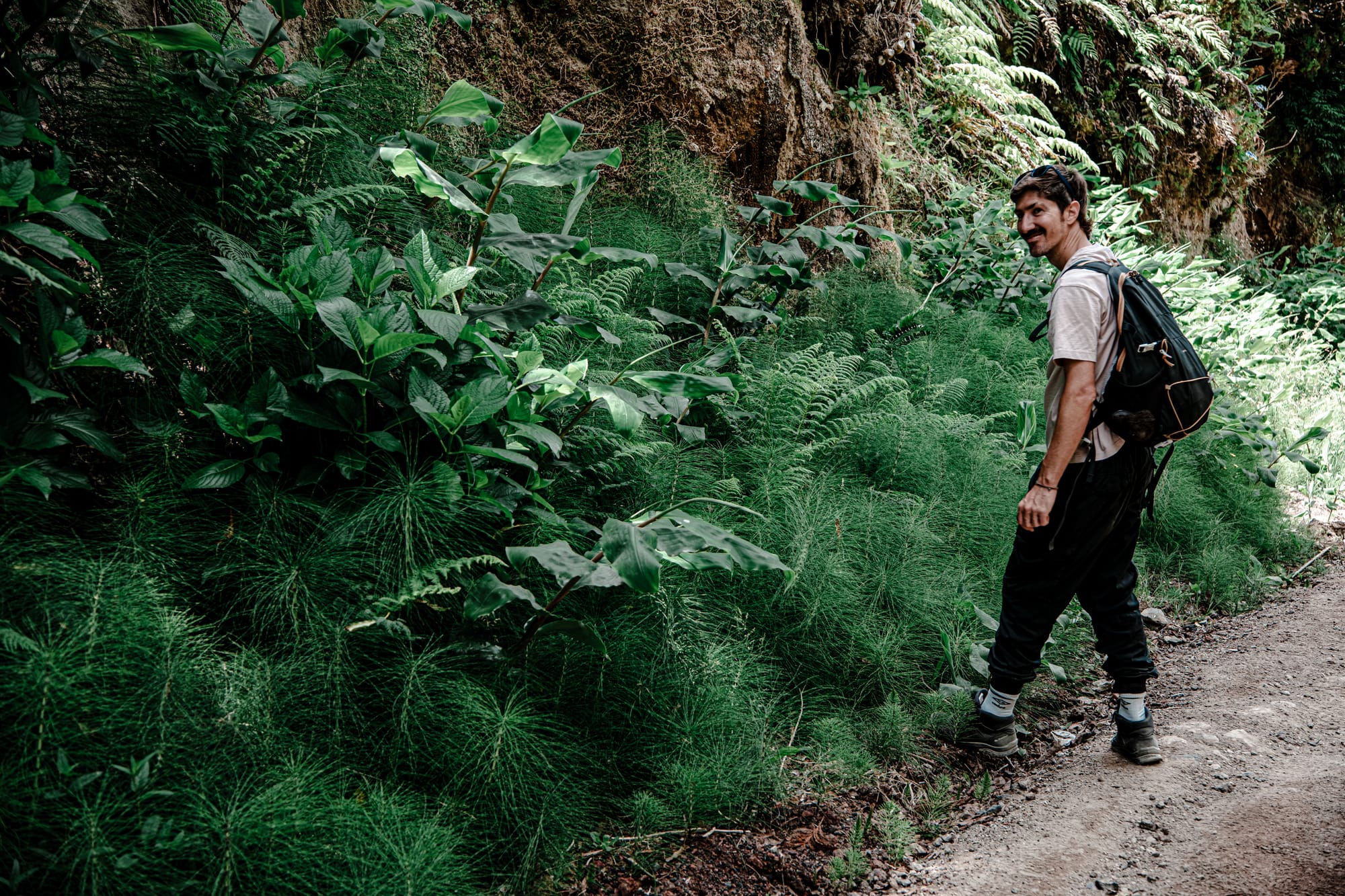
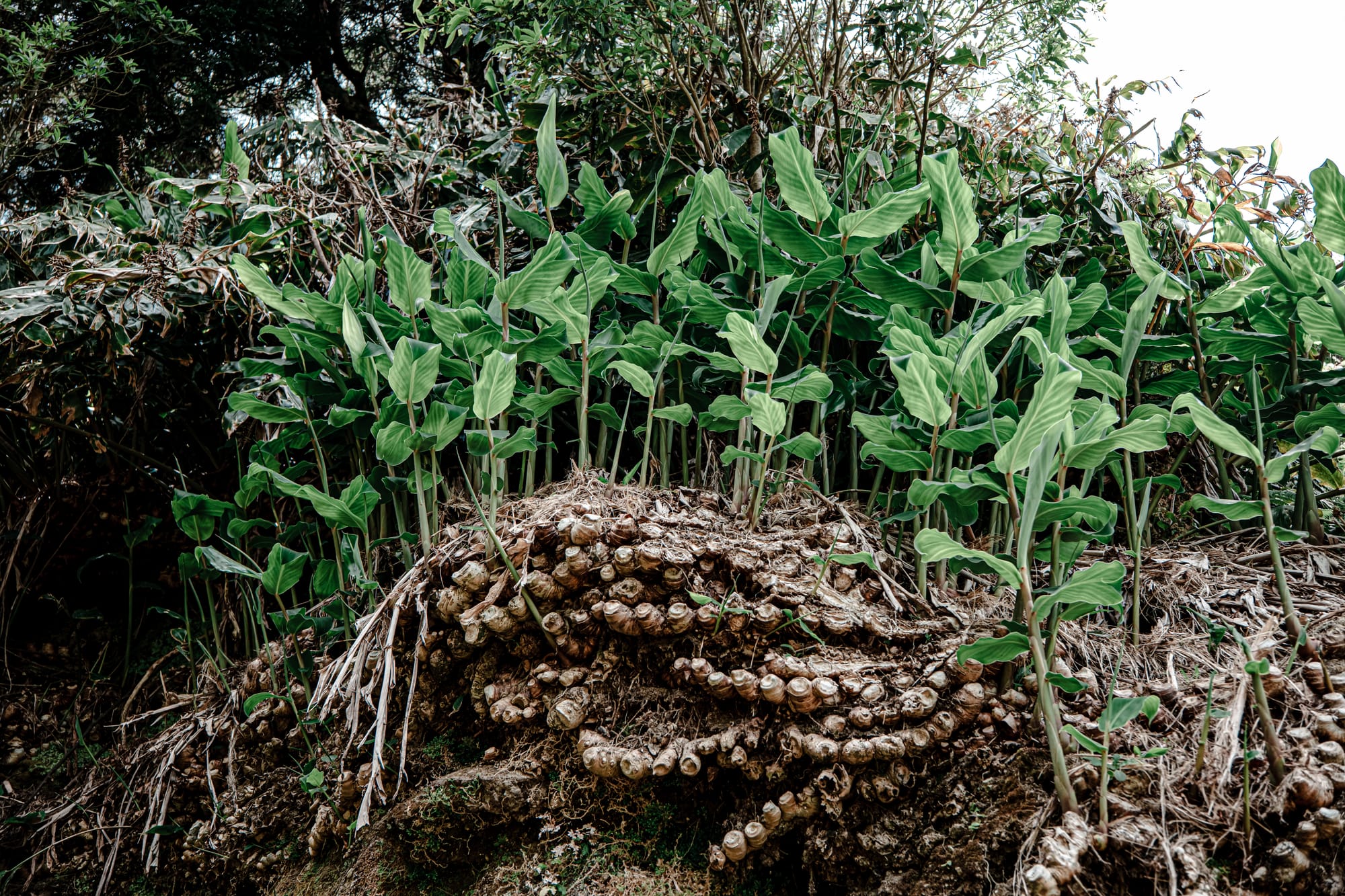
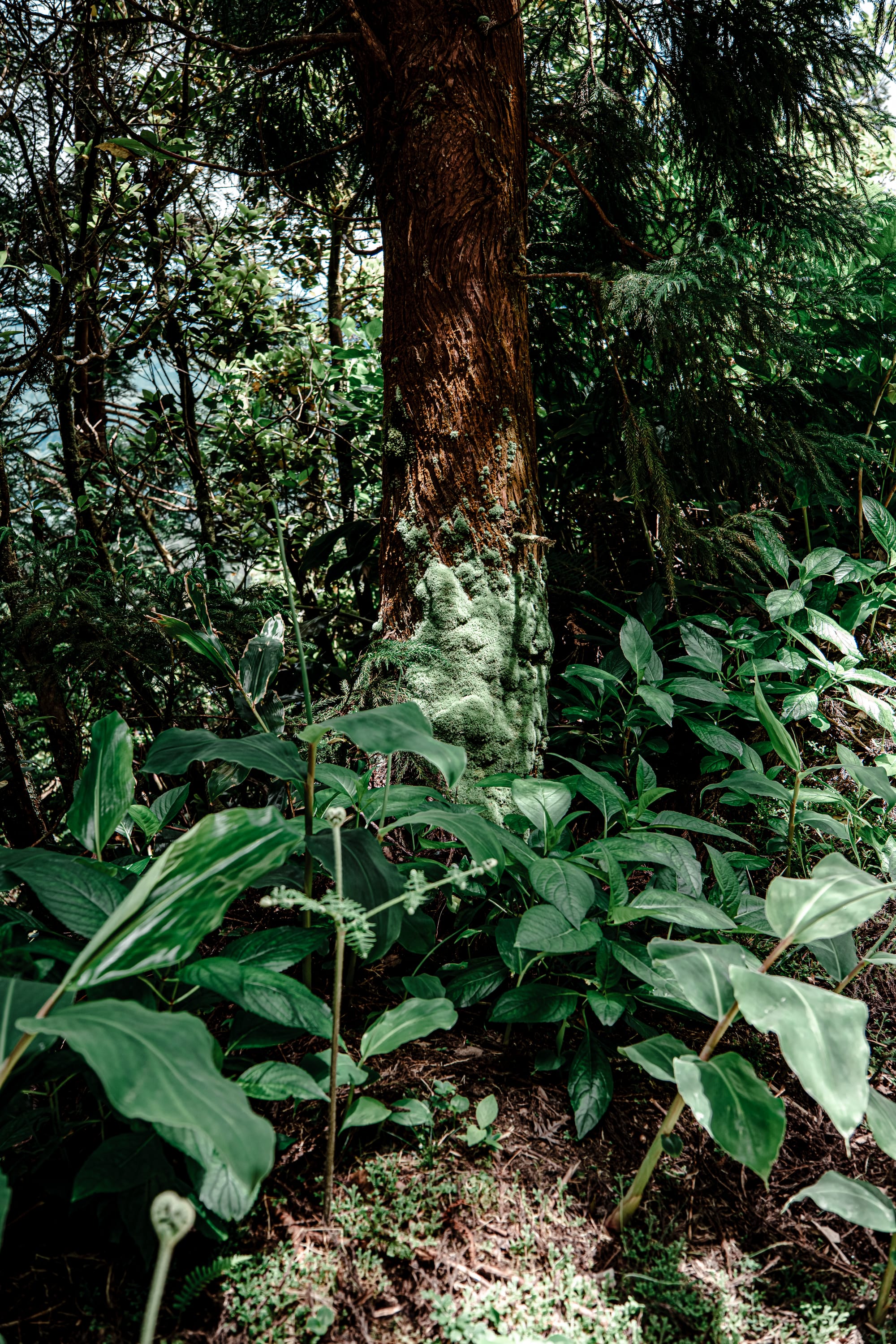
Lush, layered greenery lines the PR3-SMI trail—ginger leaves, ferns, and wildflowers thrive under the forest canopy
And then, with little fanfare, you arrive.
The town of Sete Cidades
Sete Cidades is quiet. It feels protected—sheltered by the caldeira walls and held close by the lakes. The town itself is small, mostly one- and two-story homes, some with basalt foundations and whitewashed walls, others with gardens spilling over with hibiscus, azaleas, and more hydrangeas than you thought possible.
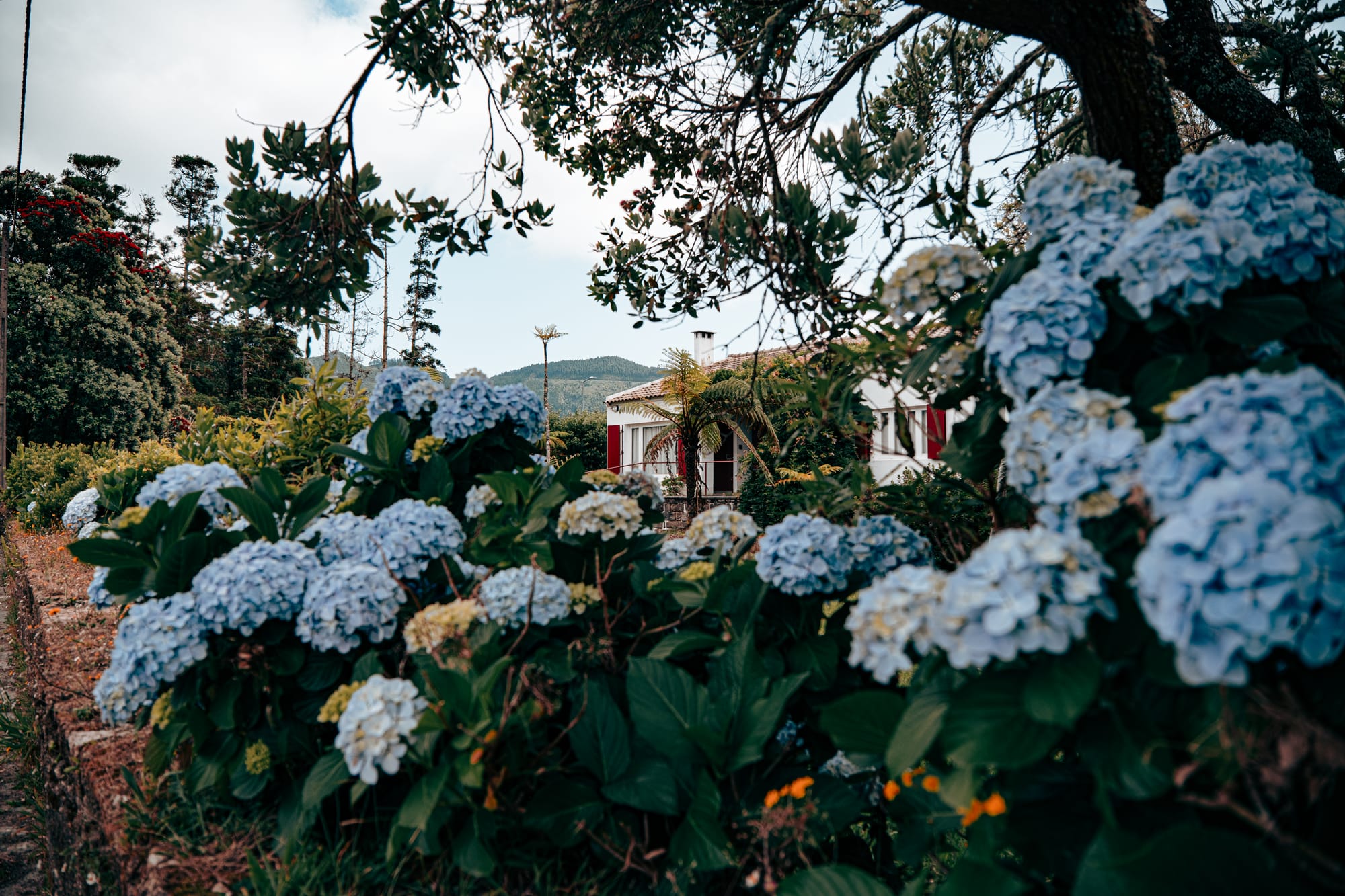
In and around the village, you’ll walk past corridors of wild ginger, ferns, and bottlebrush trees, with cycads pushing up spiraled cones beside basalt walls. Hydrangeas are omnipresent—spilling from gardens, clustering along roadsides, and forming soft tunnels of bloom.
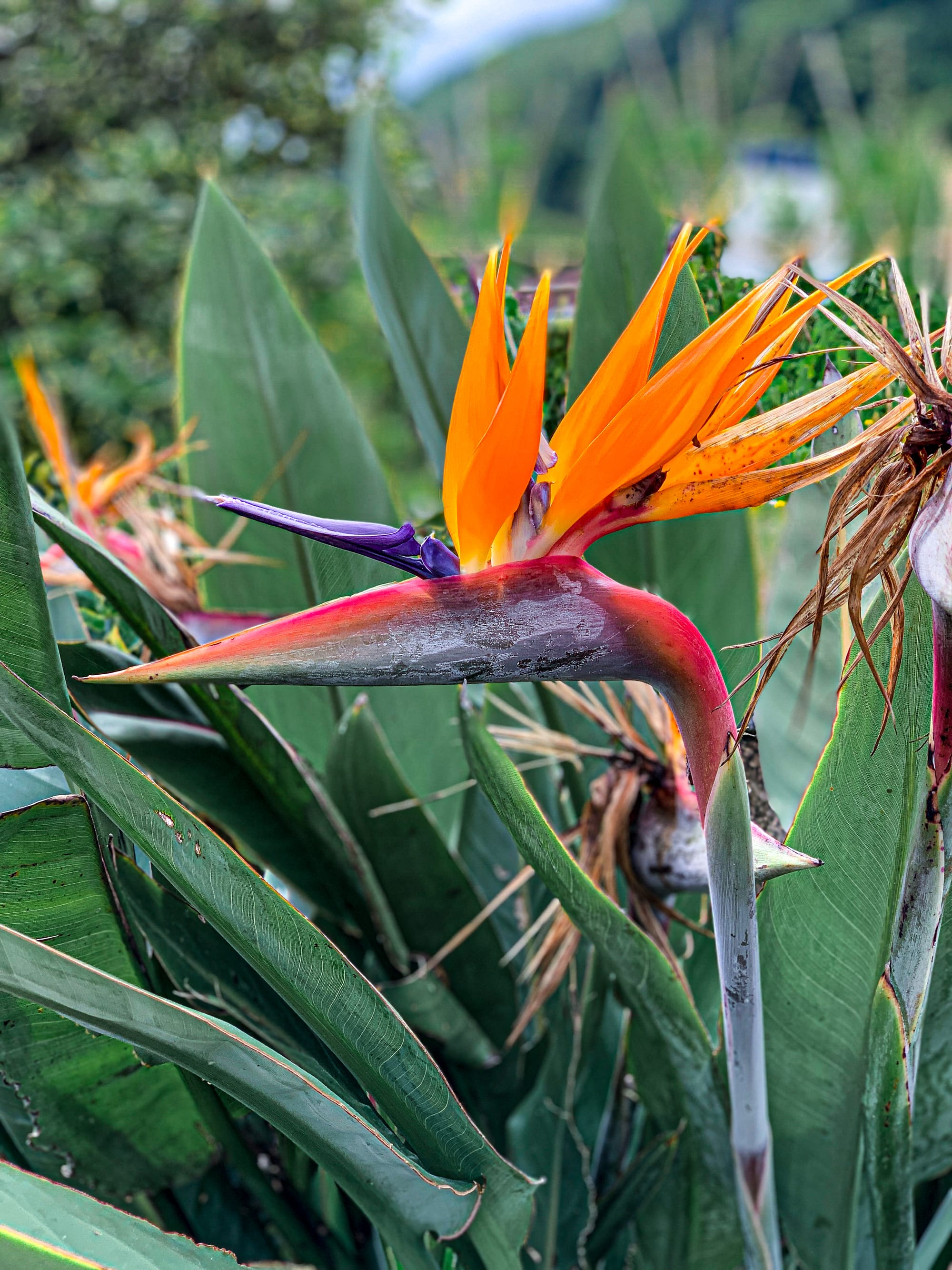
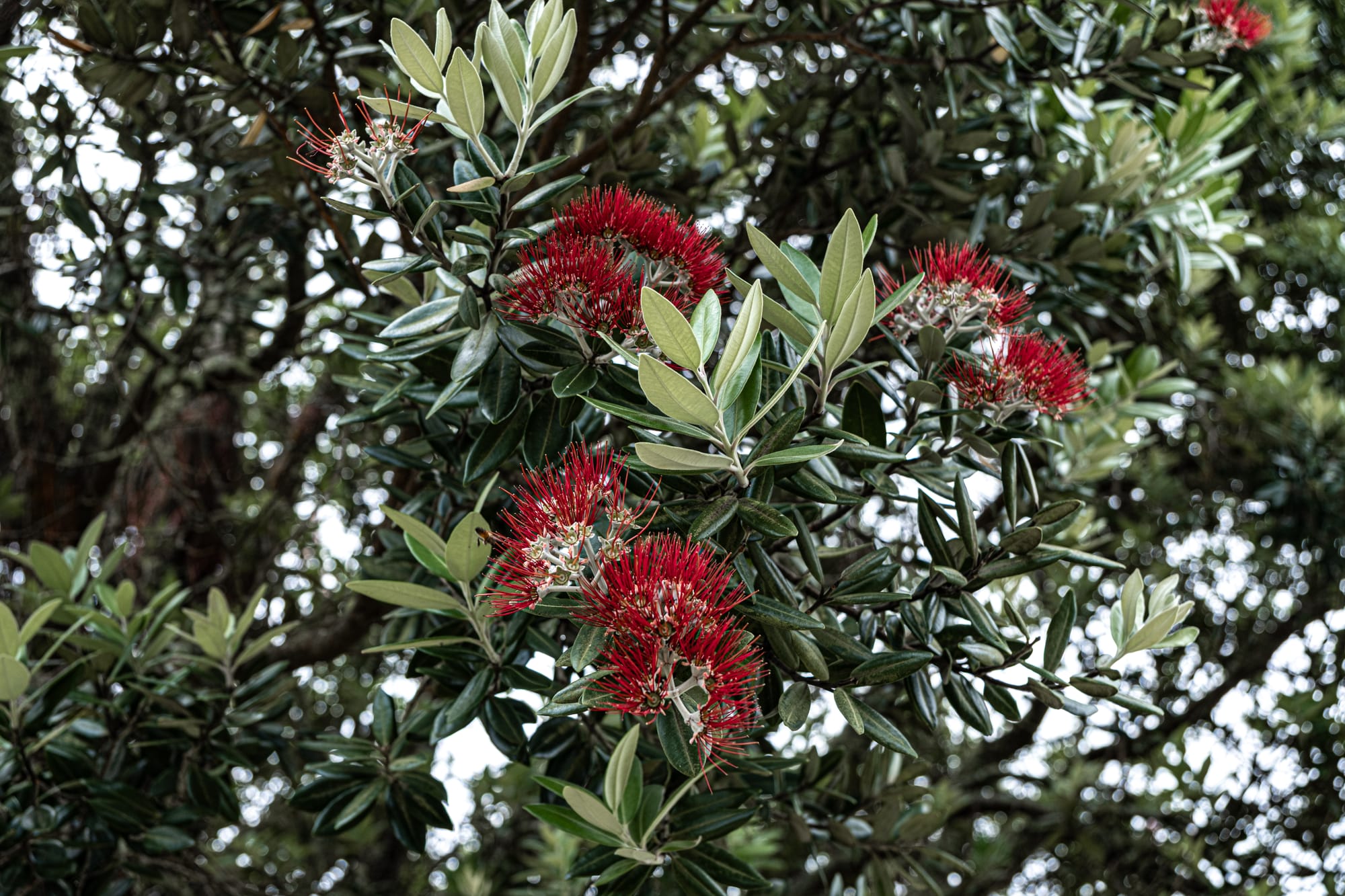
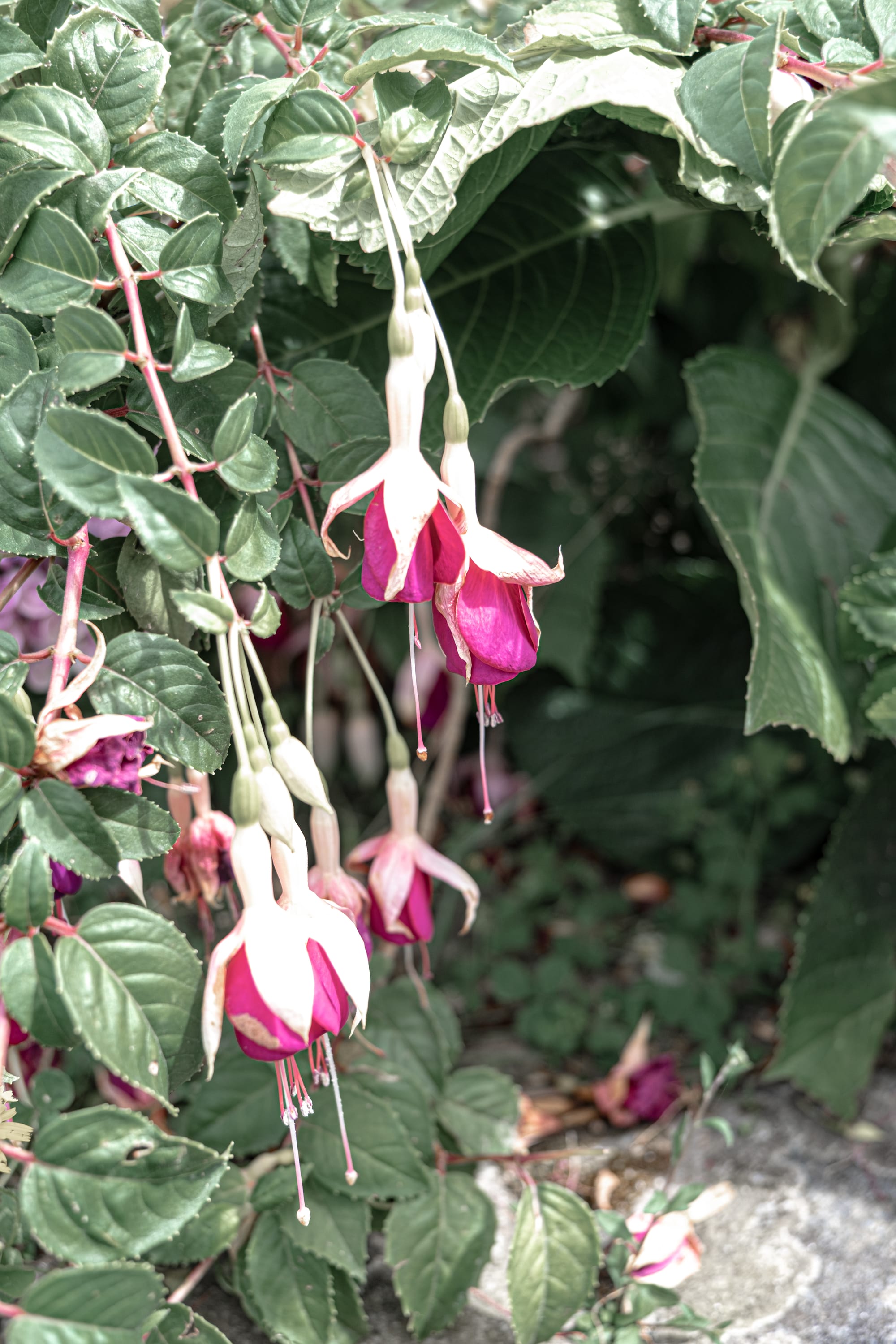
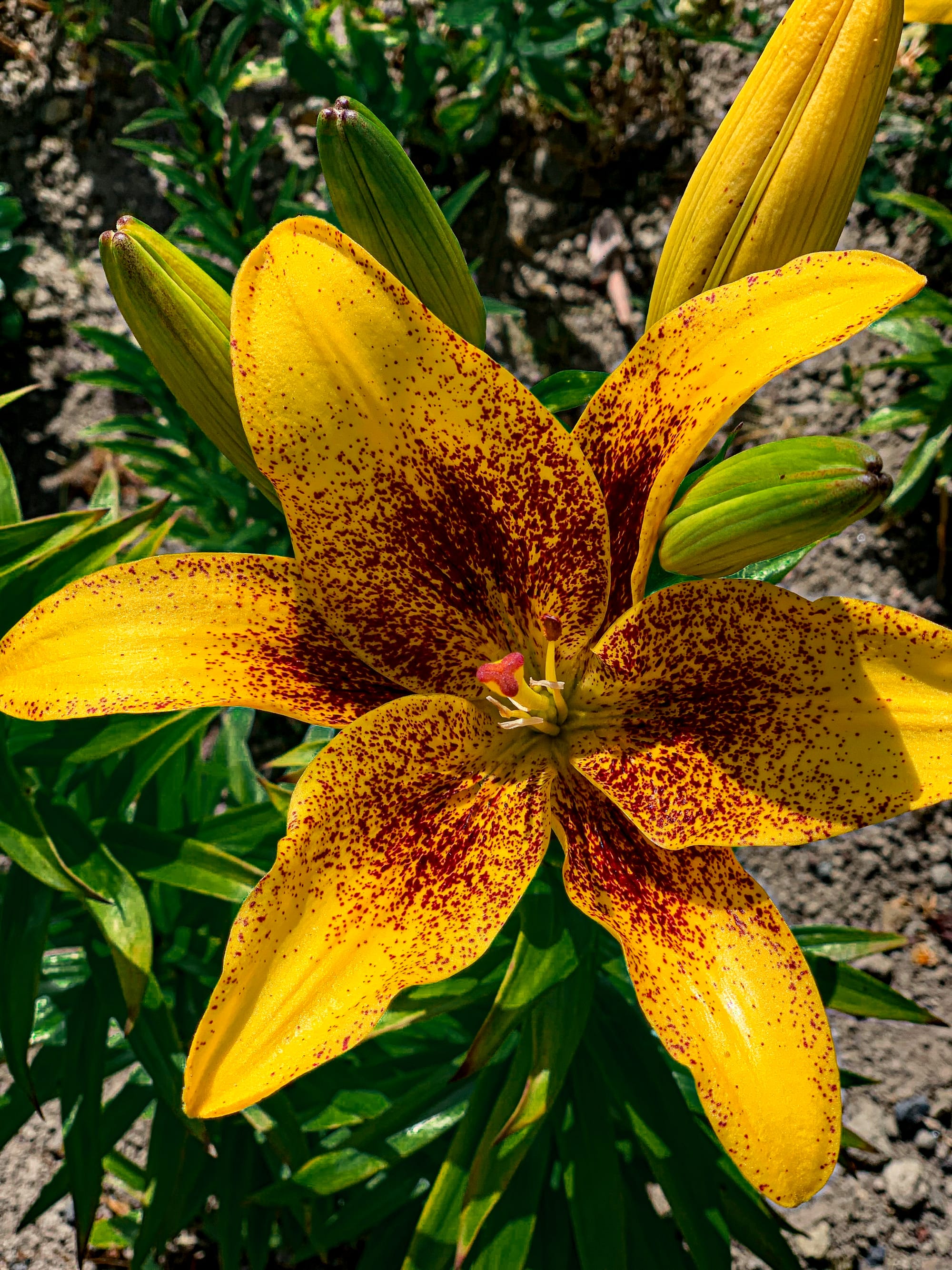
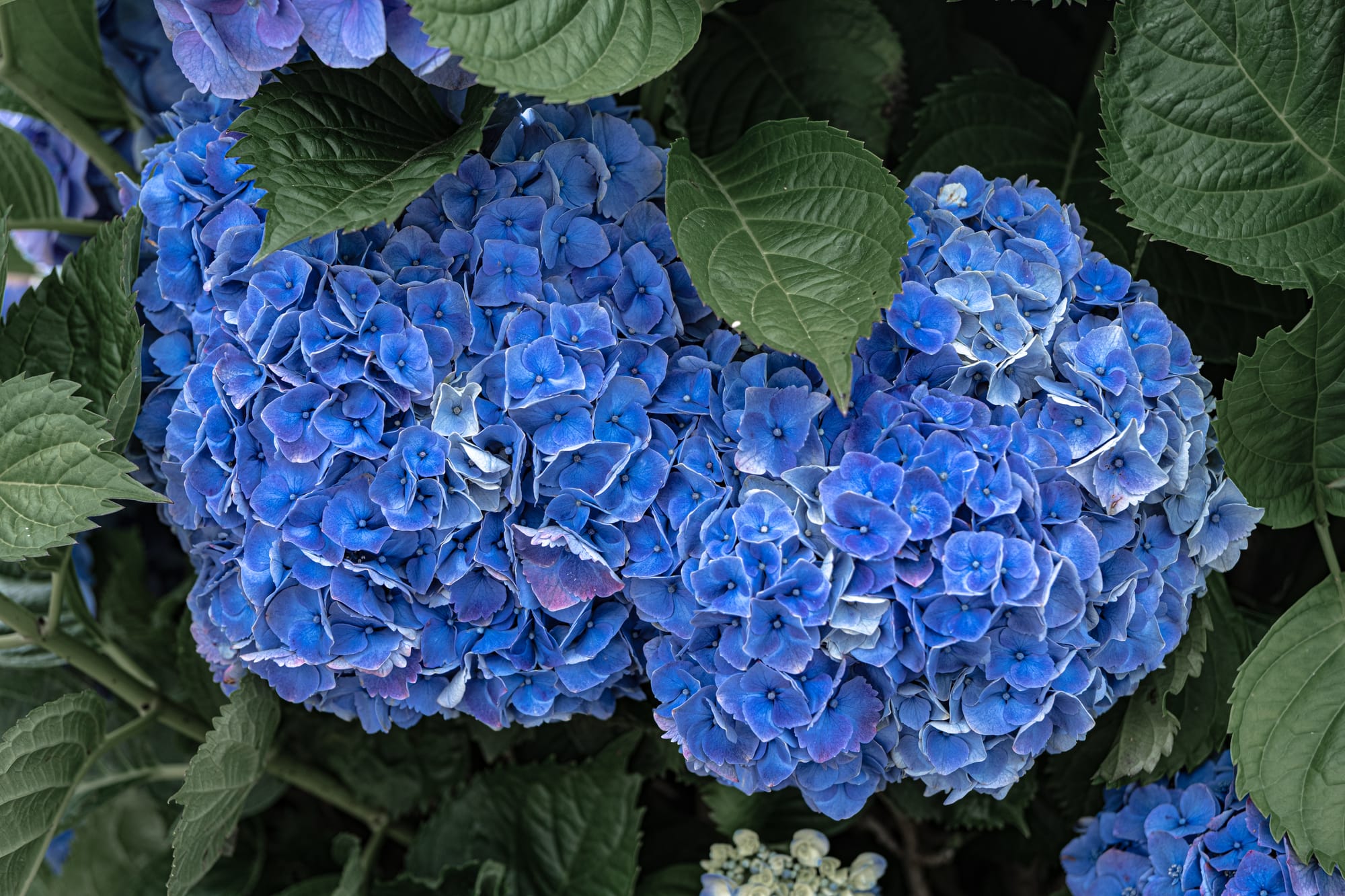
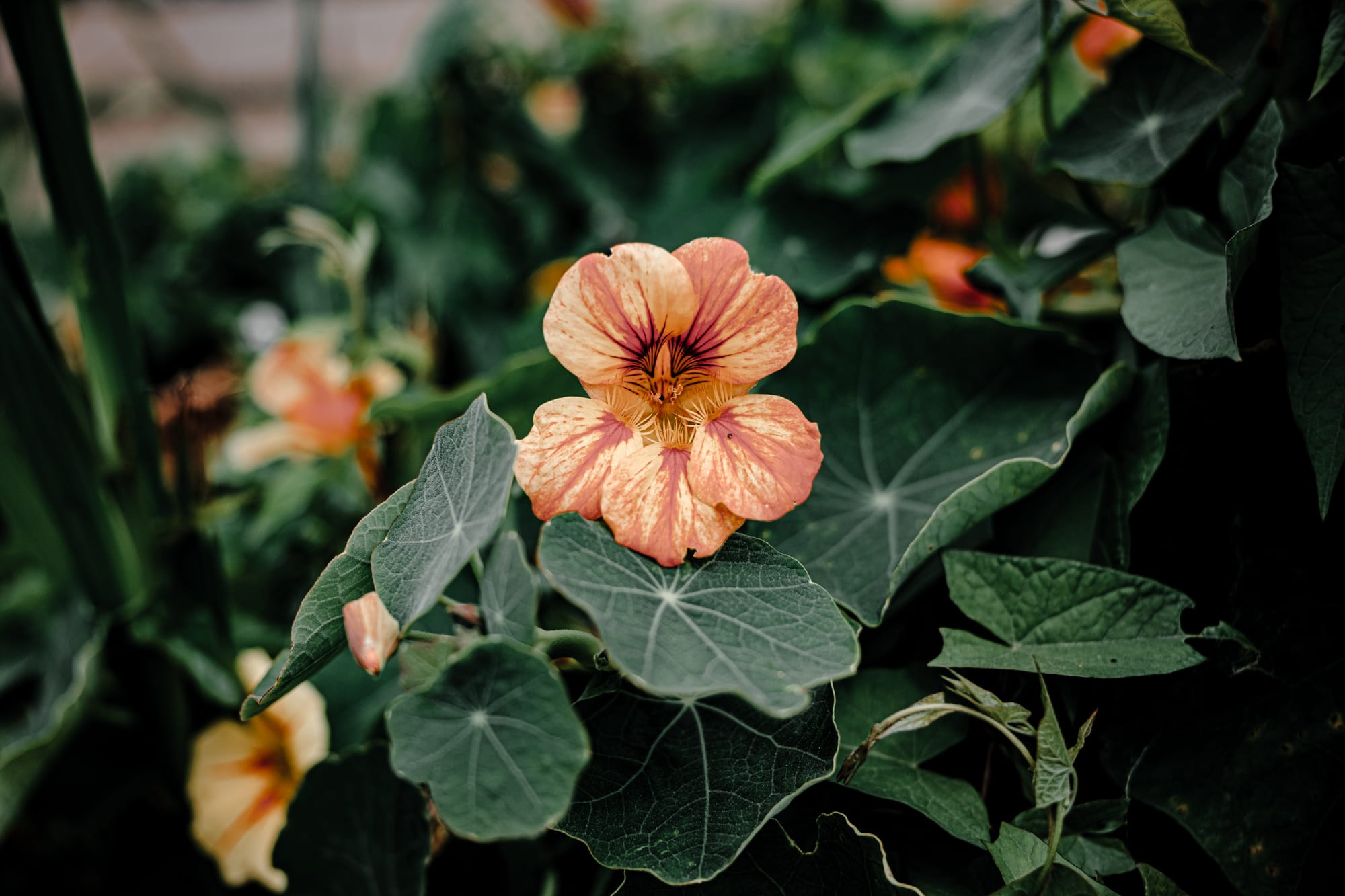
Some of the vibrant blooms seen in and around Sete Cidades, from bird of paradise to nasturtiums
In the shadier corners of town, tree ferns spread their fronds wide while old volcanic rock walls drip with lichen and water. Every few hundred meters, the environment shifts—domestic and wild interwoven.
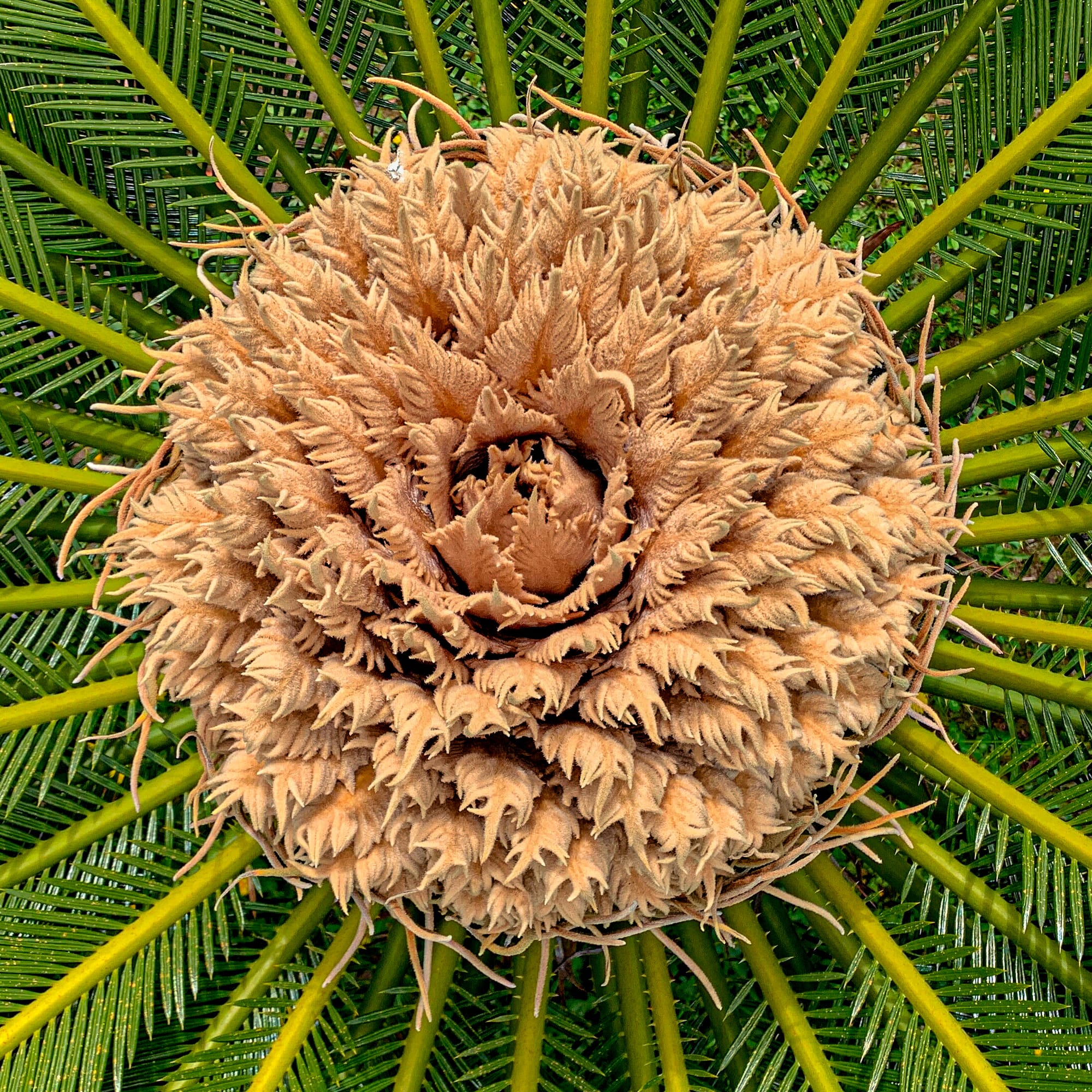
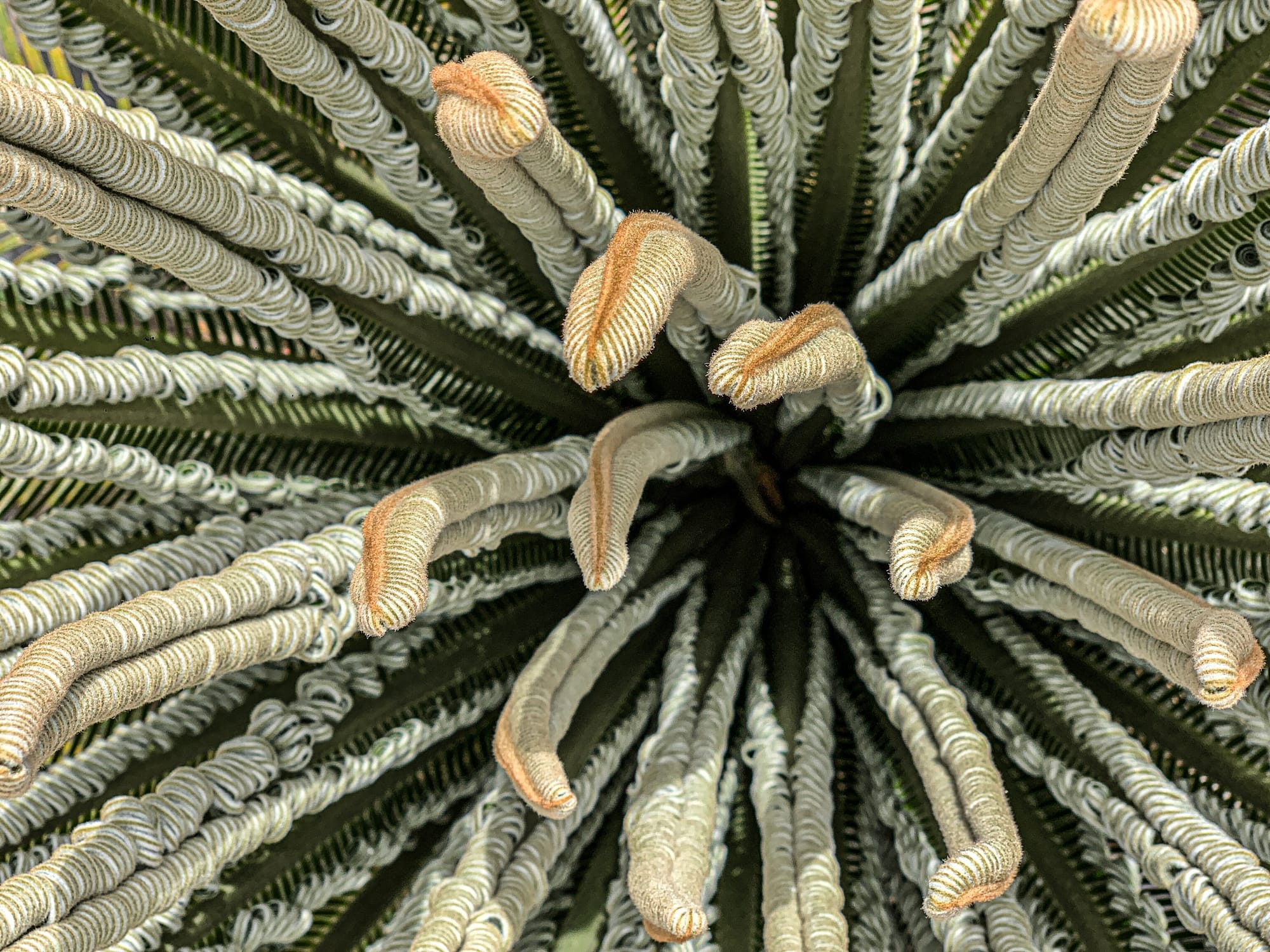
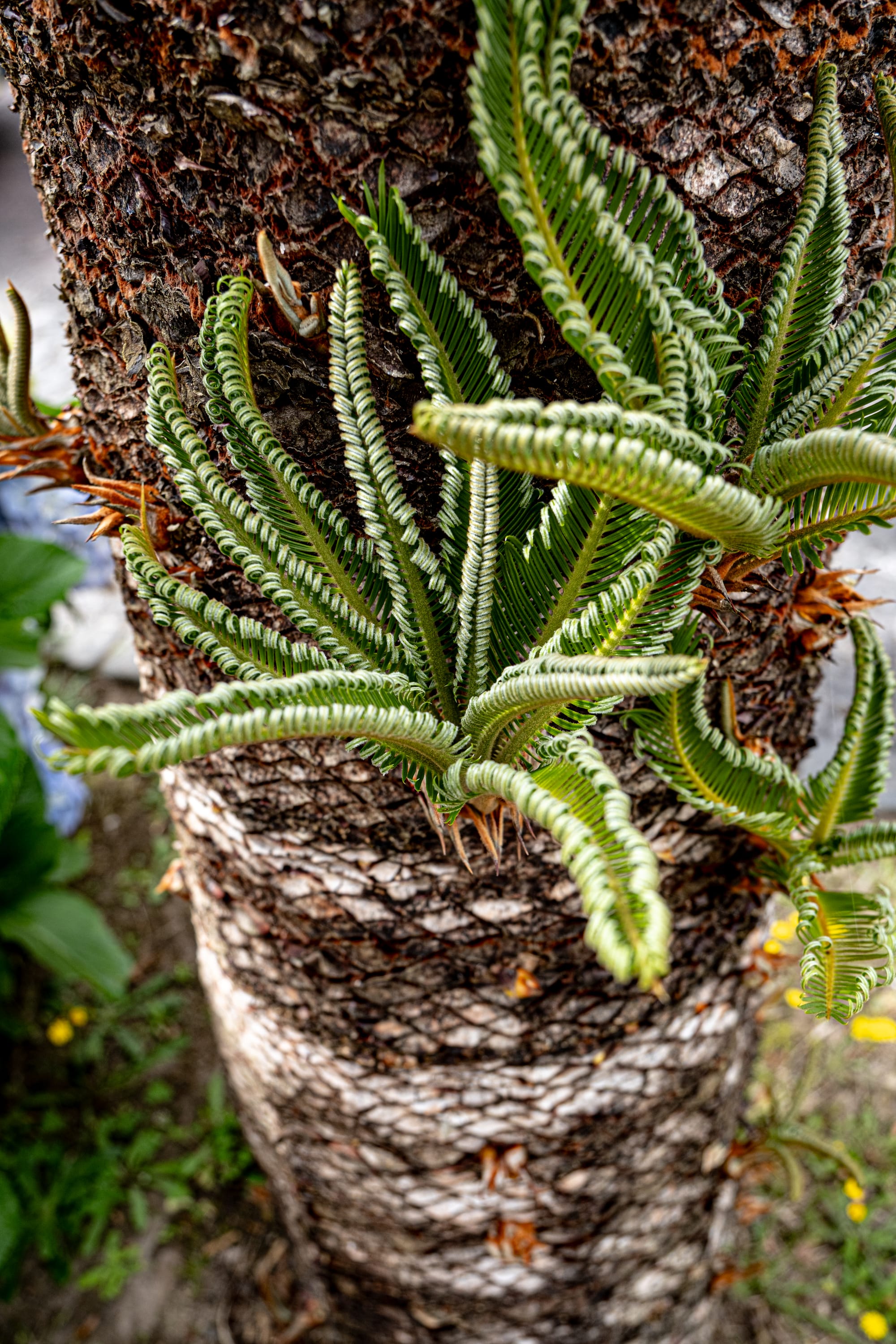
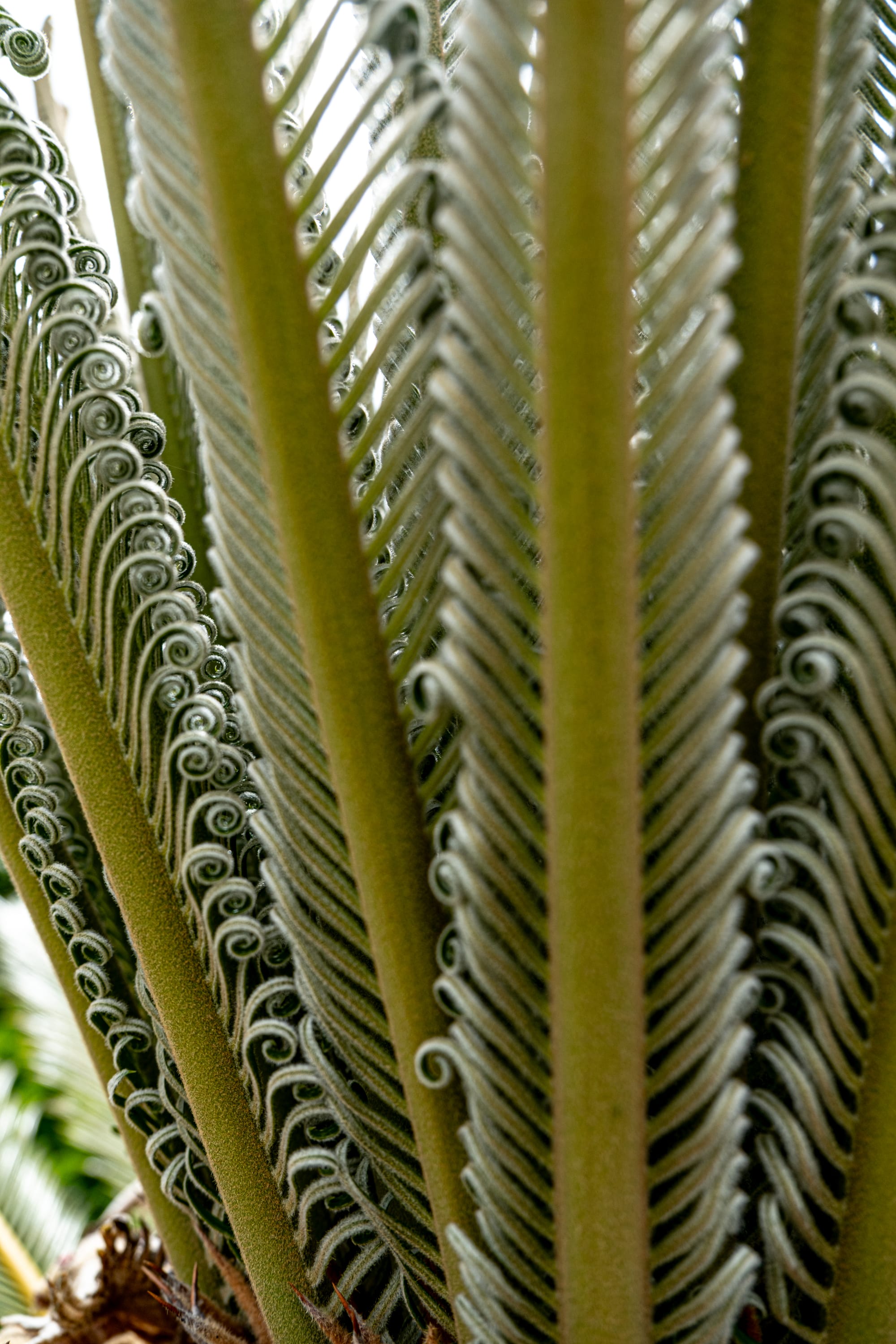
Close-up views of cycad fronds and cones, a striking prehistoric plant found in the Azores’ lush volcanic gardens
The rhythm is slow here. You’ll hear the occasional bleat of a goat, the clink of a teacup, the soft sound of water lapping at the lake’s edge. Children bike past on narrow roads. A café might offer espresso, bolo lêvedo, and a view across Lagoa Azul.
There’s a small whitewashed church—Igreja de São Nicolau—with a black basalt trim, gothic windows, and a sharp steeple. Its courtyard is shaded by towering trees, one of which you photographed with a spiraling root system that looks older than the church itself.
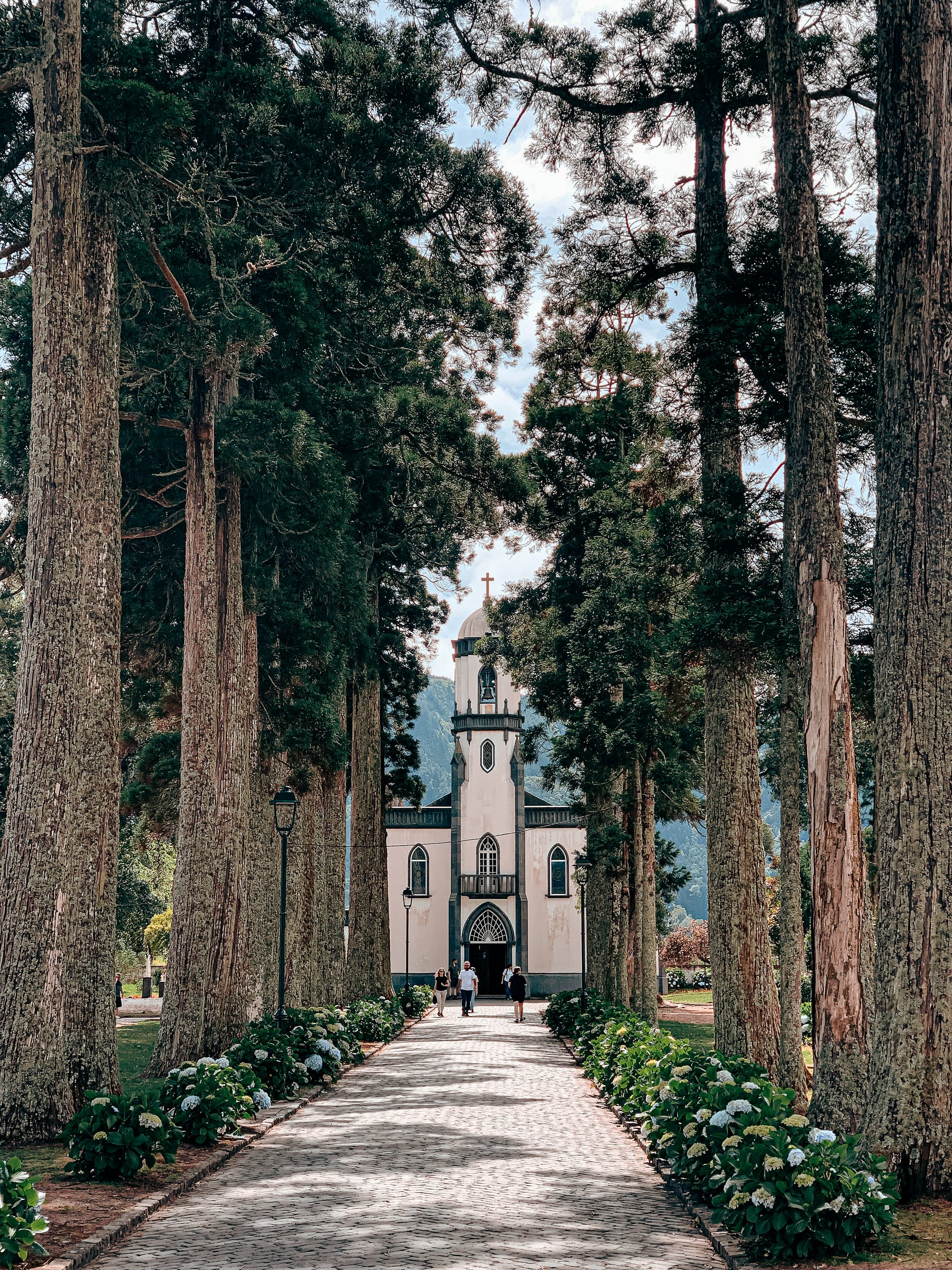
The town’s main road leads you to a stone walkway along the lakeside. Locals fish or sit with their feet in the water. Ducks paddle past.
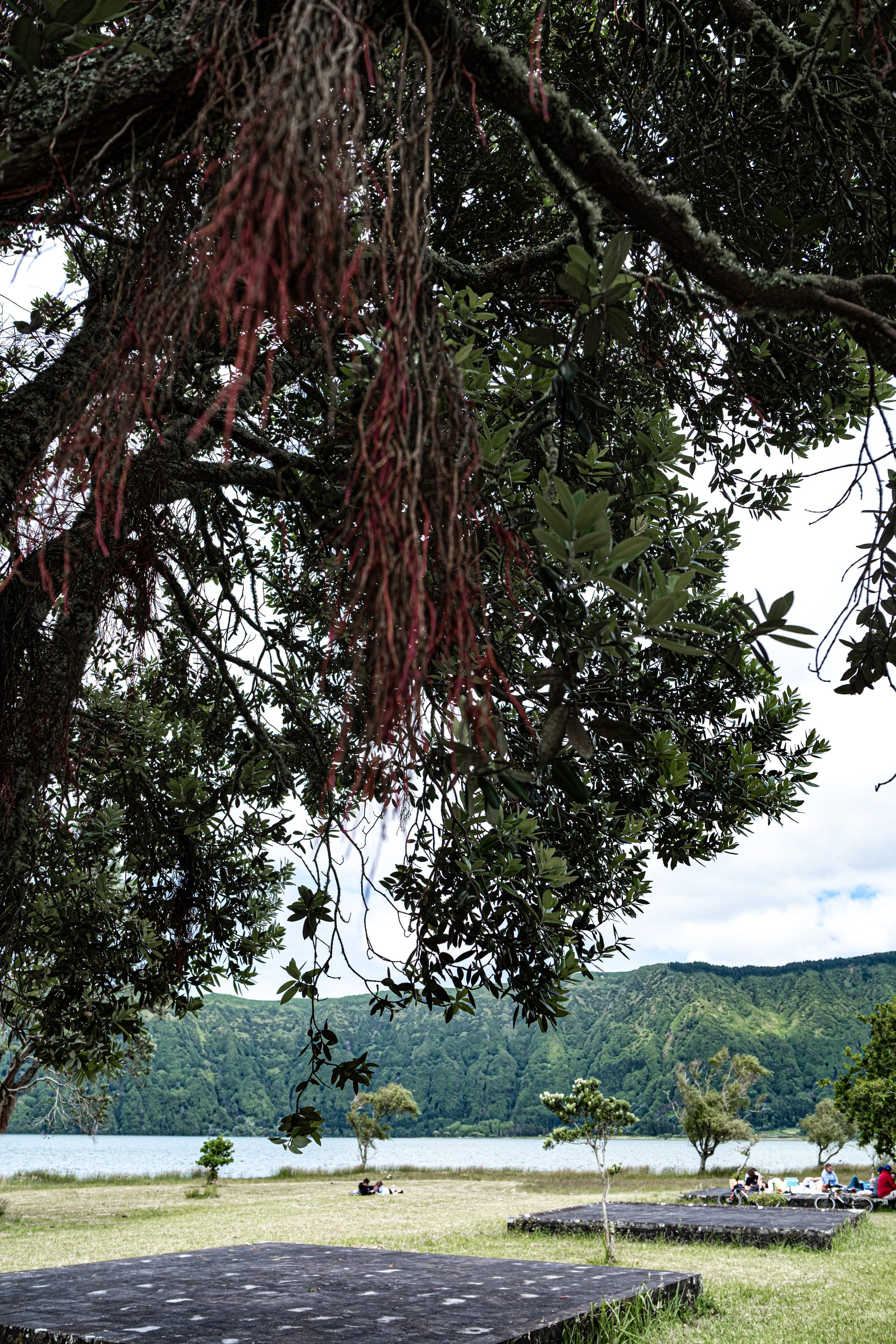
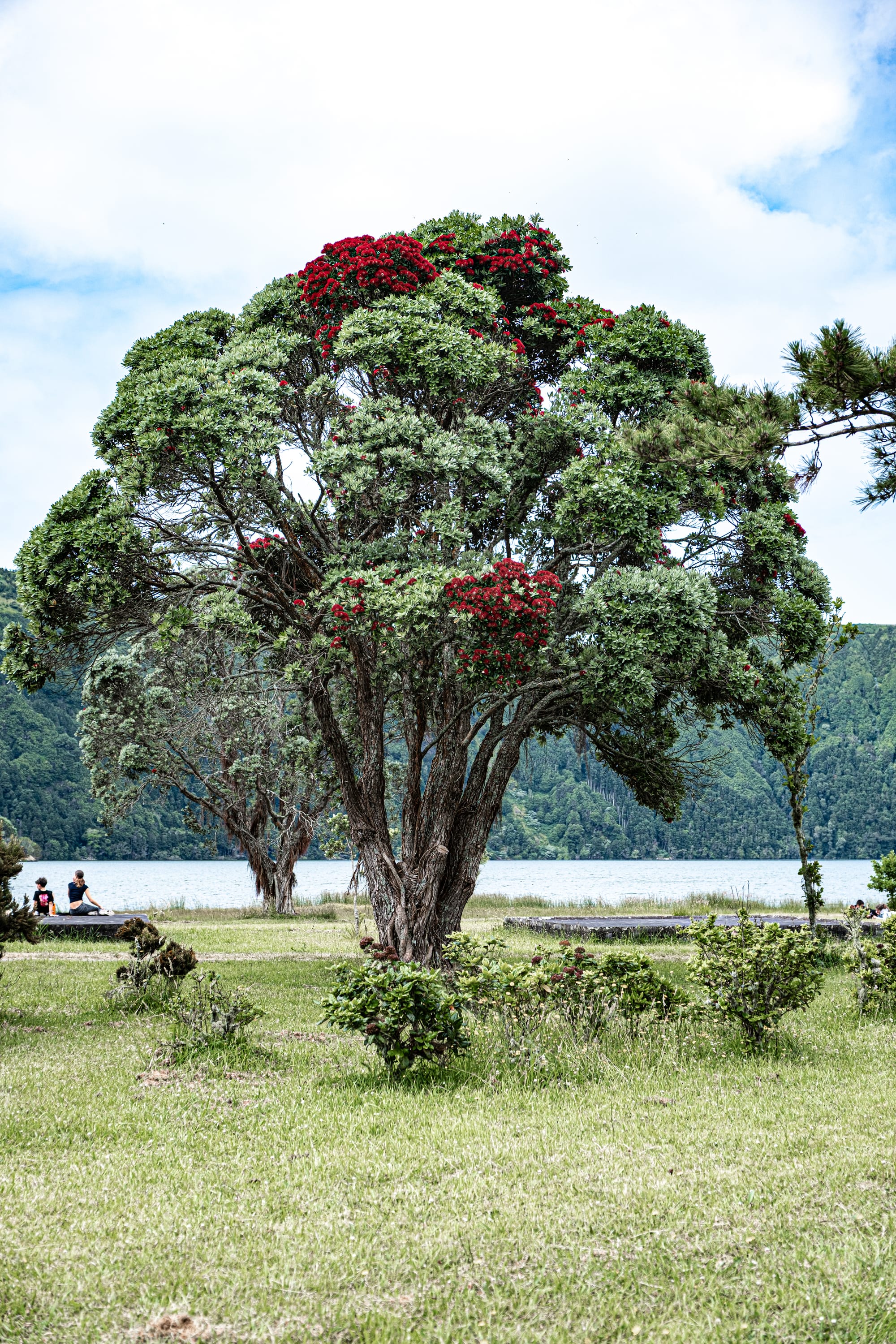
Lakeside pōhutukawa trees bloom in Sete Cidades, offering color, shade, and a sense of stillness
There are places to eat, places to pause, but mostly, Sete Cidades is a place to be. To rest after your descent. To let the weight of the trail settle in your bones and the story of the lakes echo a little longer.
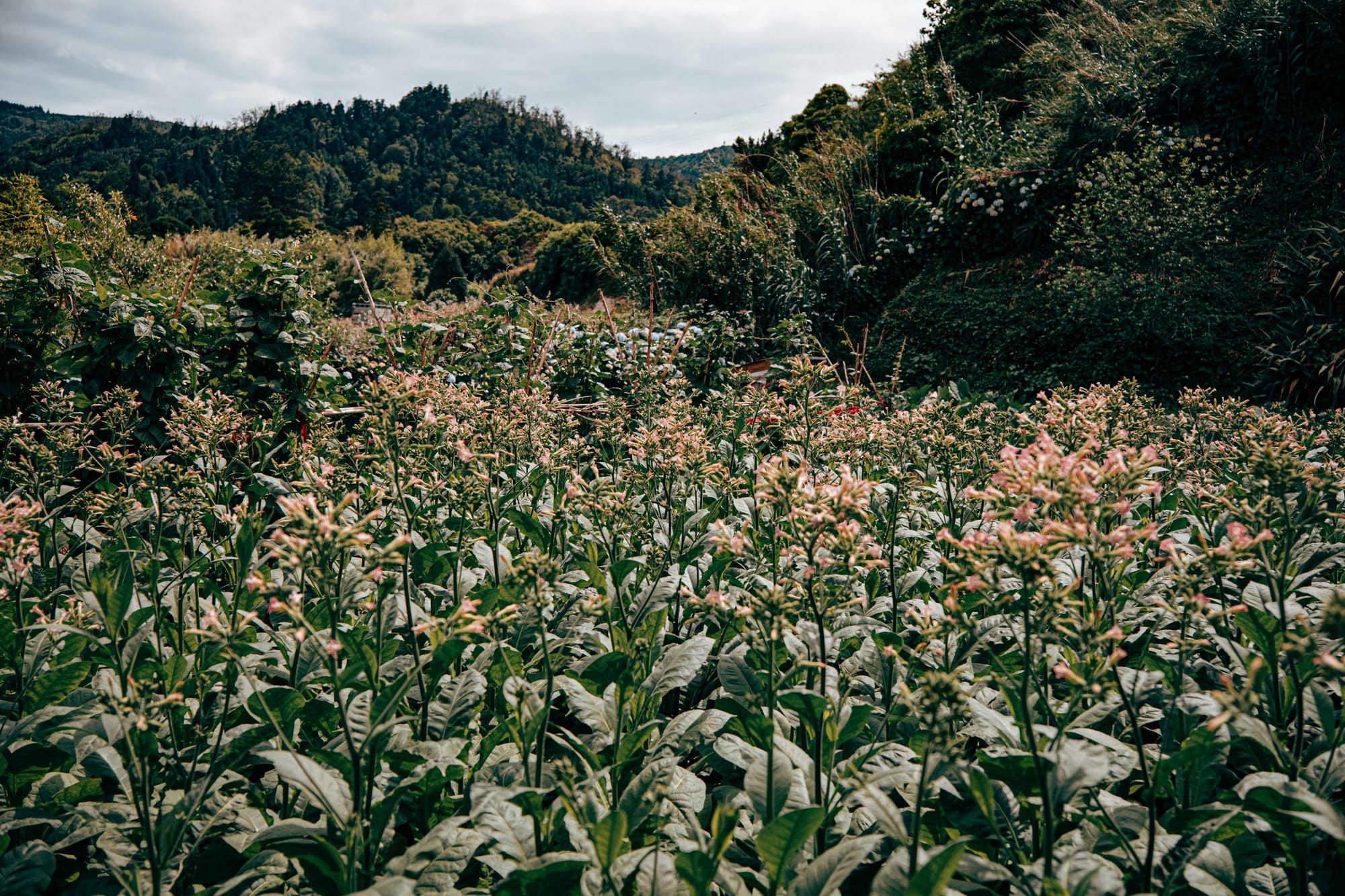
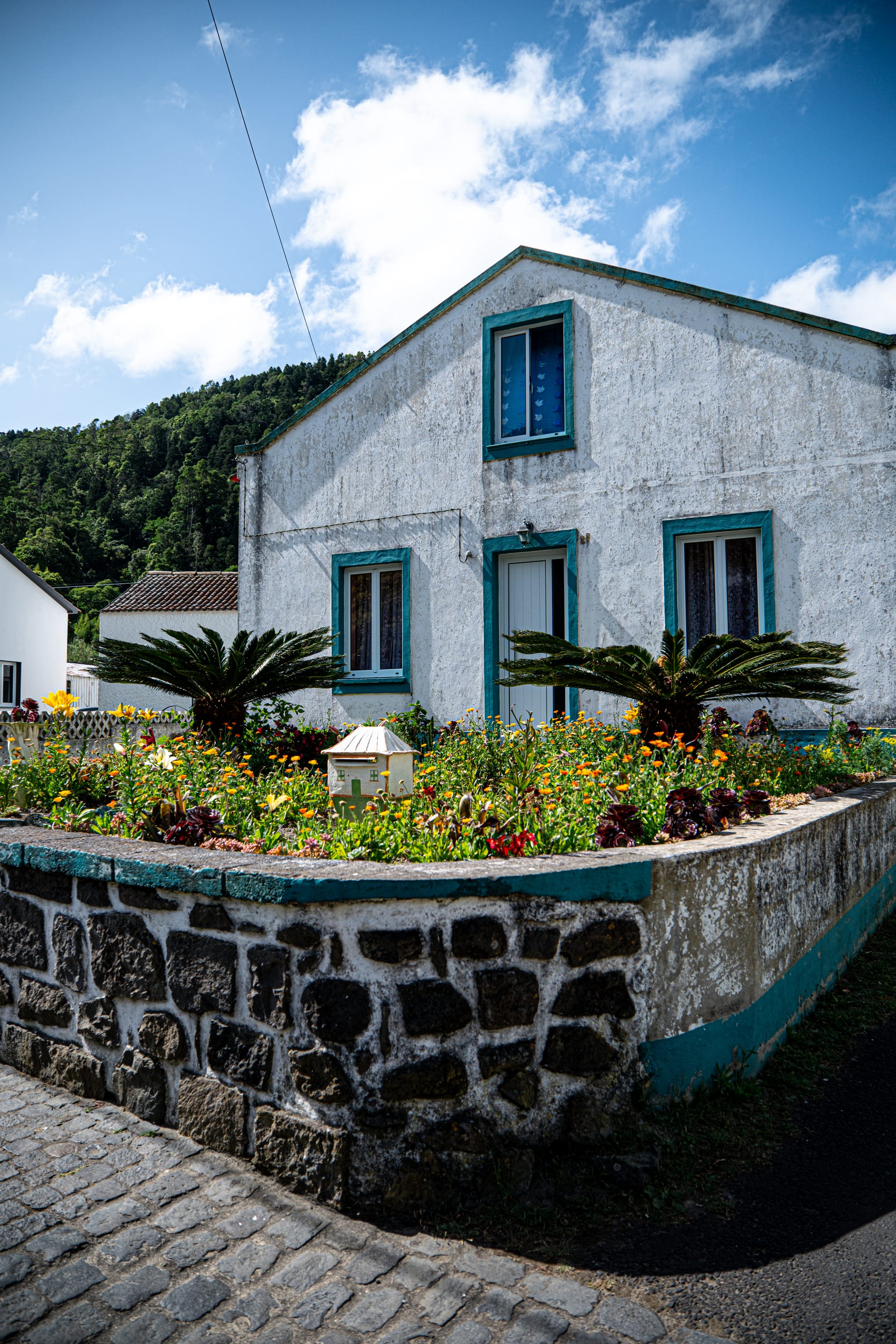
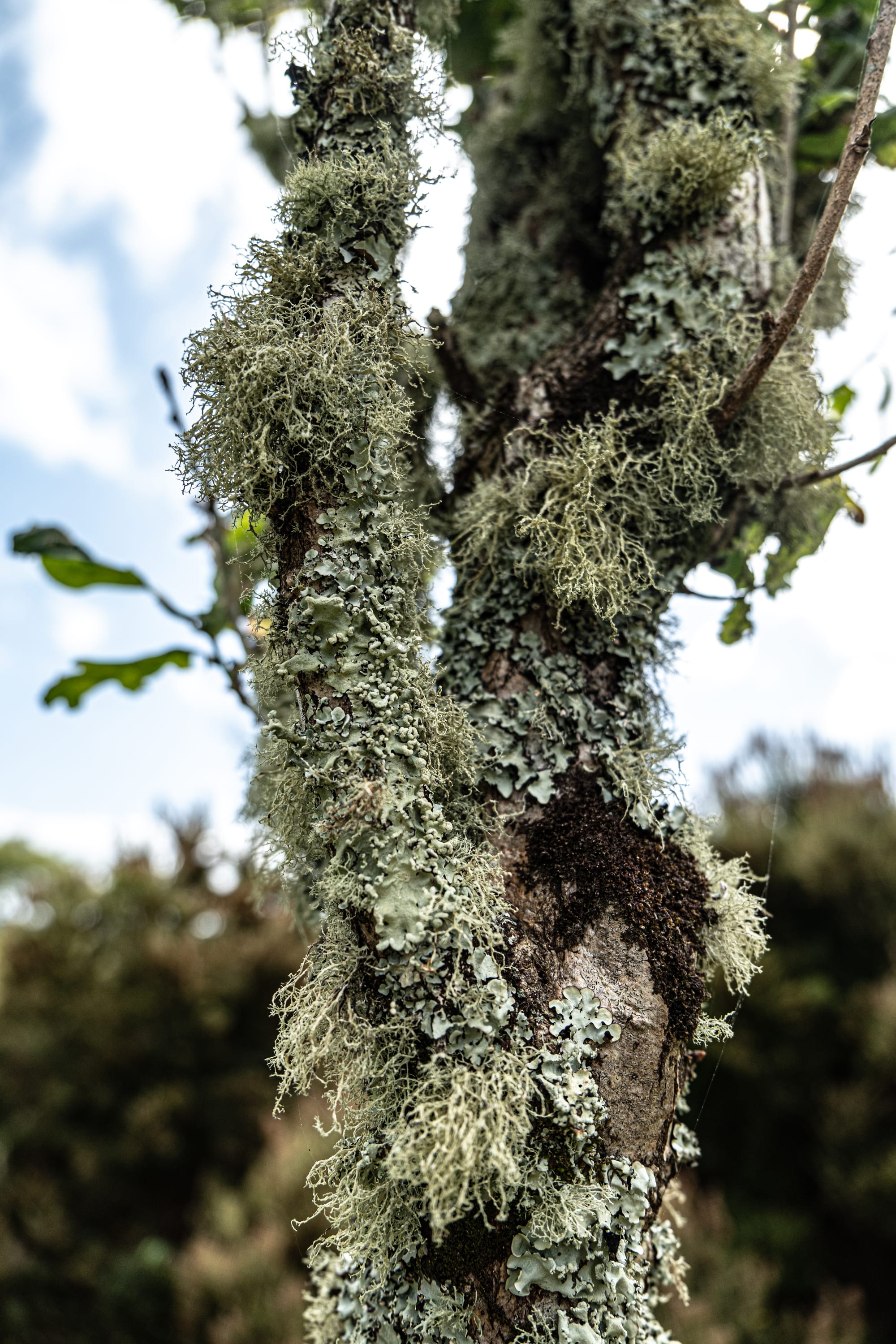
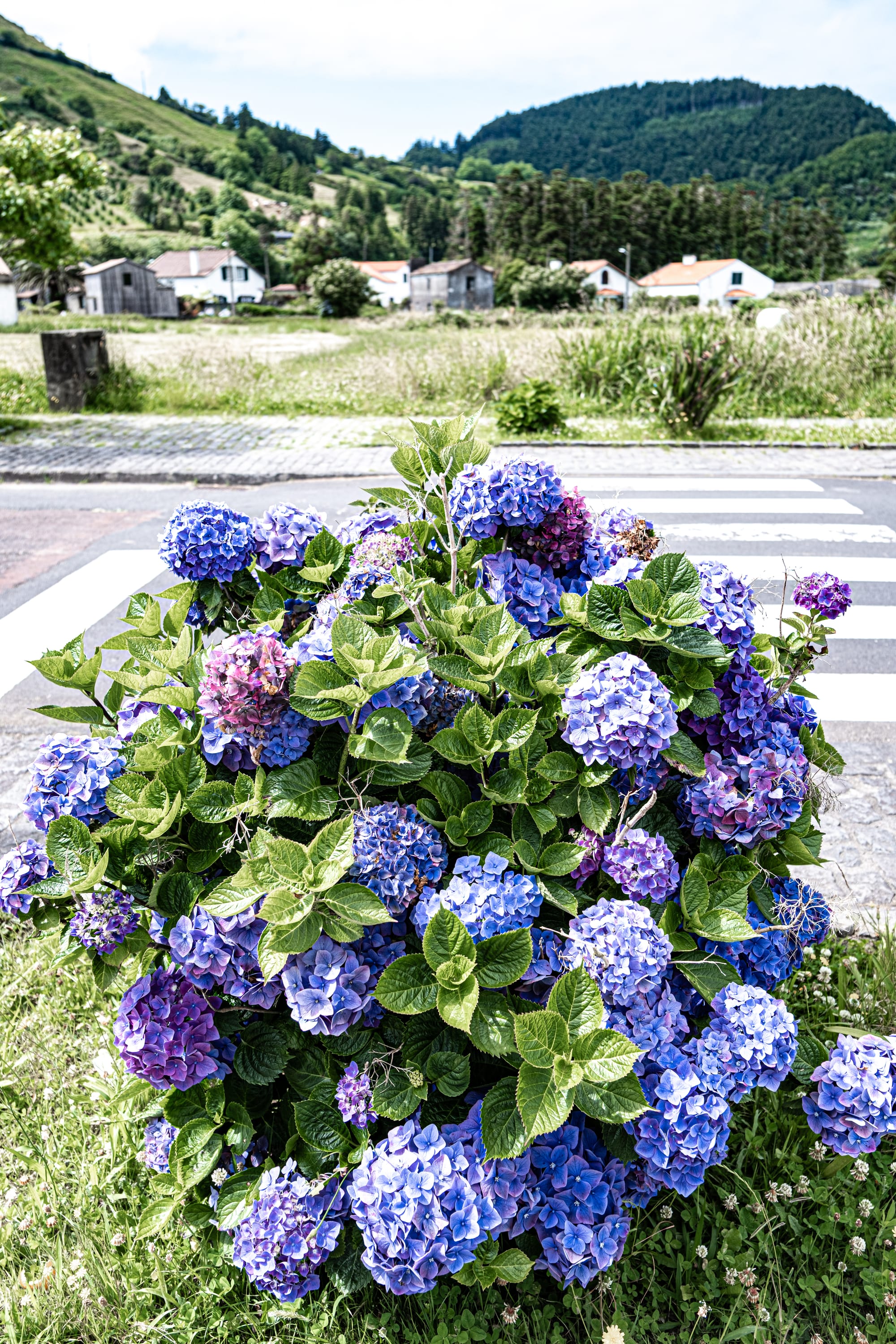
Garden plots, hydrangea hedges, and moss-draped trees shape the textures of everyday life in Sete Cidades
If you came without a plan to hike back up, you’ll find options here—taxis, shuttles, even public buses that slowly wind back up to the ridge. Or you can turn around and make the journey again in reverse, seeing everything anew.
What to expect along the PR3-SMI trail
The full route is approximately 9.7 miles (that's around 15.6 km) and takes several hours, depending on pace and stops. It’s mostly downhill, beginning from the heights of Vista do Rei and gradually spiraling down into the lush caldeira valley. The trail itself is varied: dirt tracks, gravel roads, mossy forest floors, and open pastoral stretches.
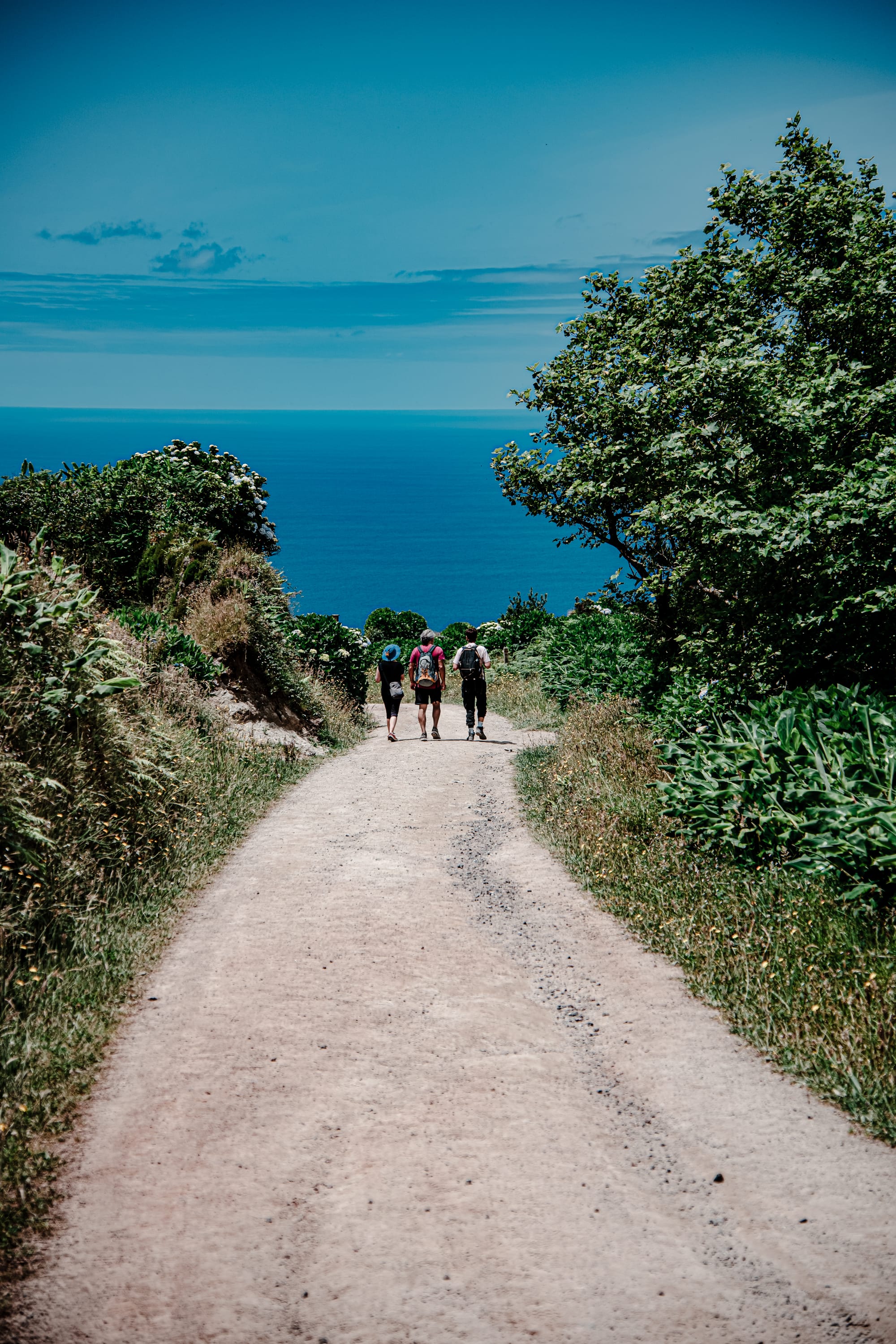
Views are frequent and evolving. Early on, you’ll see sweeping panoramas of both lakes. Further in, the trail narrows into green tunnels before opening again to wider farm lanes, distant ocean views, or a sudden break where you spot Sete Cidades far below.
Tips for walking the trail
Start early in the day to avoid the cloud cover that often rolls in by mid-afternoon. Wear proper footwear, as parts of the trail—especially after rain—can be muddy or slick. There is no food or water along the route, so bring enough for the entire walk.
Dress in layers. Even on sunny days, the weather can change quickly. And if you’re prone to taking breaks, a hat and sunscreen are worthwhile. The trail has minimal signage, so it’s good to download a GPS map or trail app just in case, though the path is generally clear.
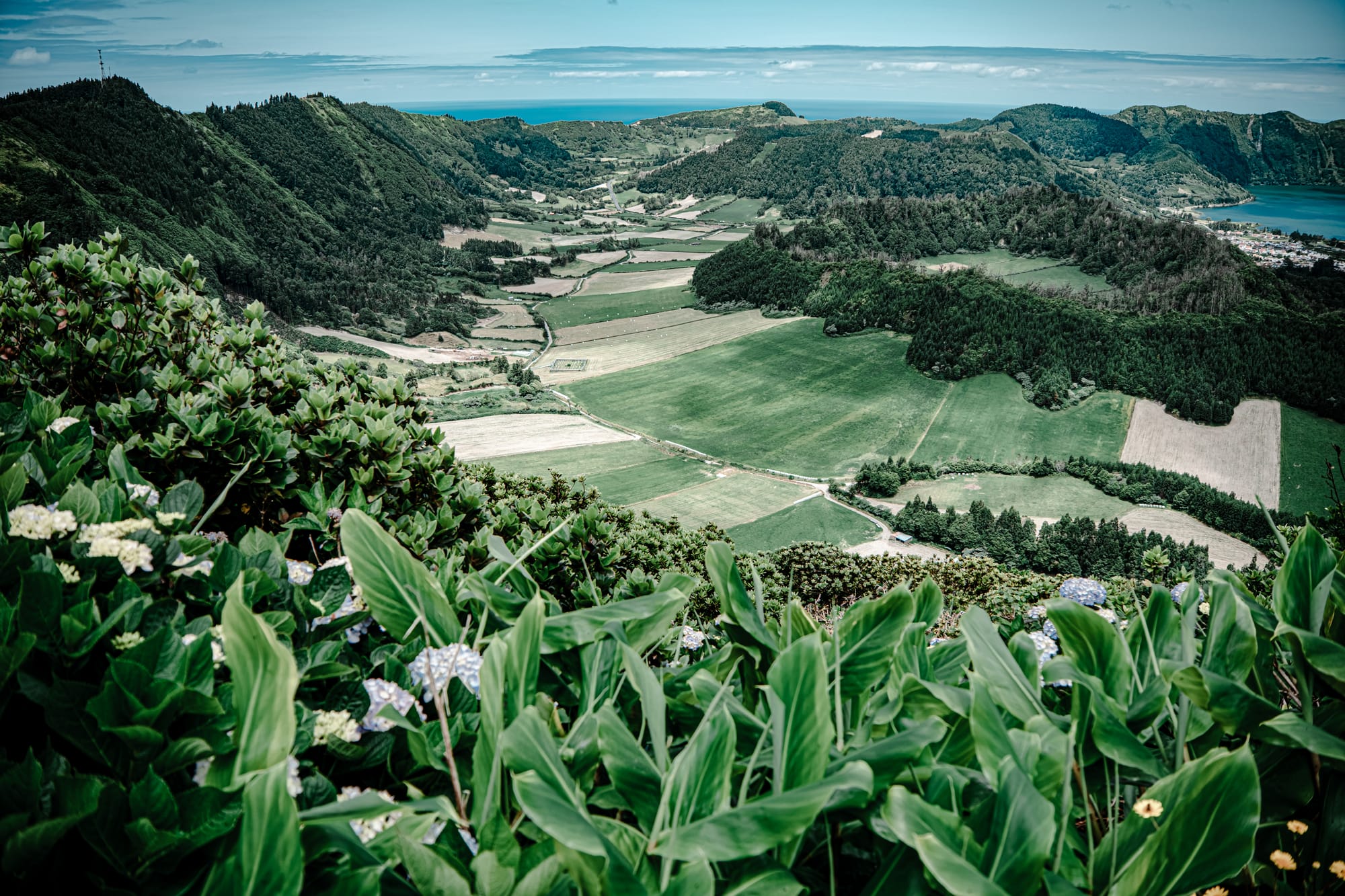
A camera is essential, but don’t forget to pause and take it all in without the lens. This is one of the island’s most sensory hikes—flowers to smell, wind to hear, stone to feel beneath your feet.
Don’t want to go solo?
There are several hiking tours around Sete Cidades, some following different paths. This one doesn't follow the same path, but is shorter in length and includes some beautiful lagoas in the area.






